Speculative Architecture: History, Advantages, Disadvantages Analysis
VerifiedAdded on 2023/06/13
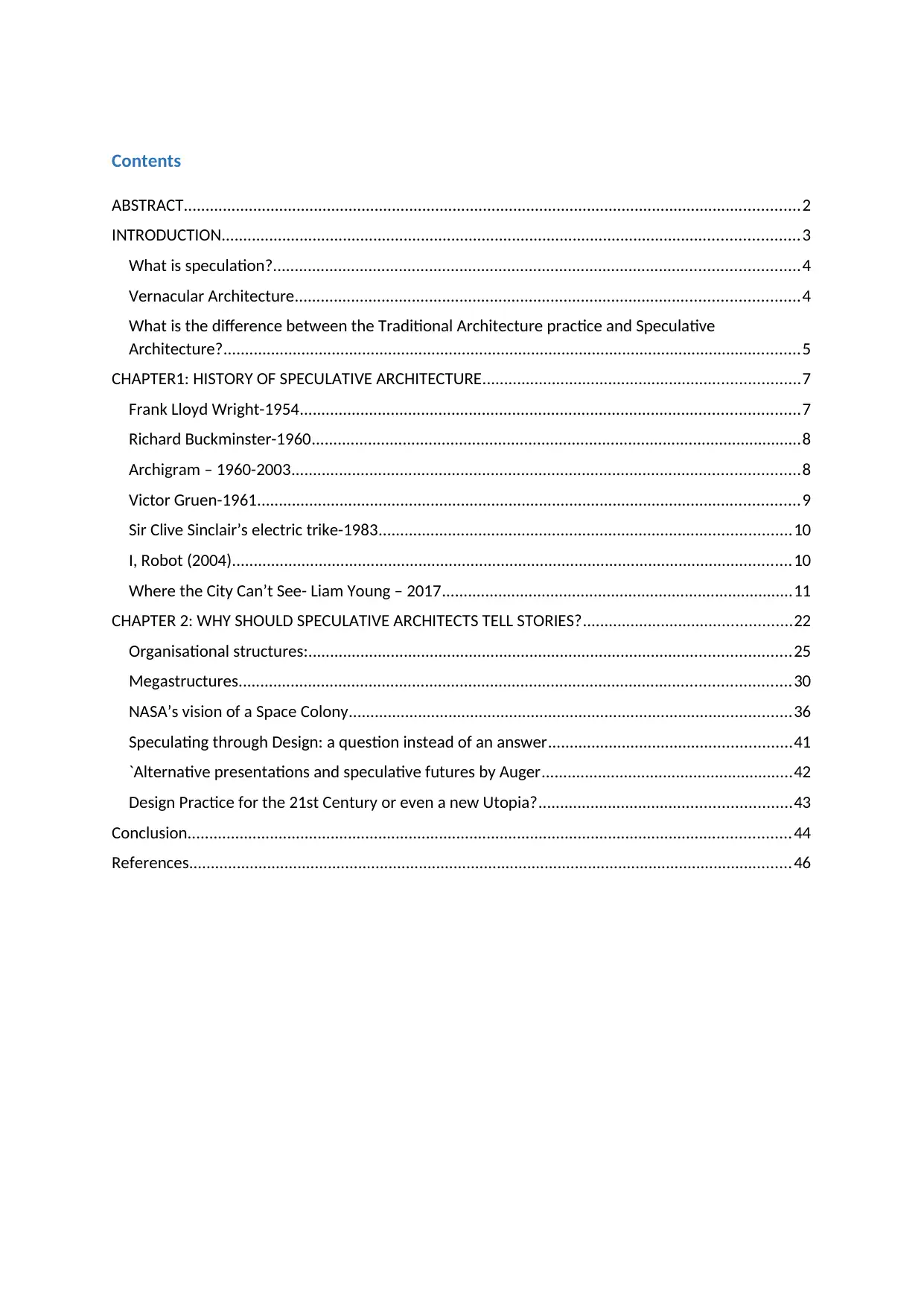
ABSTRACT..............................................................................................................................................2
INTRODUCTION.....................................................................................................................................3
What is speculation?.........................................................................................................................4
Vernacular Architecture....................................................................................................................4
What is the difference between the Traditional Architecture practice and Speculative
Architecture?.....................................................................................................................................5
CHAPTER1: HISTORY OF SPECULATIVE ARCHITECTURE.........................................................................7
Frank Lloyd Wright-1954...................................................................................................................7
Richard Buckminster-1960.................................................................................................................8
Archigram – 1960-2003.....................................................................................................................8
Victor Gruen-1961.............................................................................................................................9
Sir Clive Sinclair’s electric trike-1983...............................................................................................10
I, Robot (2004).................................................................................................................................10
Where the City Can’t See- Liam Young – 2017.................................................................................11
CHAPTER 2: WHY SHOULD SPECULATIVE ARCHITECTS TELL STORIES?................................................22
Organisational structures:...............................................................................................................25
Megastructures...............................................................................................................................30
NASA’s vision of a Space Colony......................................................................................................36
Speculating through Design: a question instead of an answer........................................................41
`Alternative presentations and speculative futures by Auger..........................................................42
Design Practice for the 21st Century or even a new Utopia?..........................................................43
Conclusion...........................................................................................................................................44
References...........................................................................................................................................46
Paraphrase This Document

Architecture and design is broadening from the ancient design and building of structures and
buildings to explaining and exploring the reasons for various changes experienced in the
cities. Architects have turned to be storytellers, explaining the various phenomena and their
anticipated impacts. Megastructure is a fundamental notion in speculative architecture and
design. This is in contravention of the traditional architecture which defines massive,
continuous and big buildings. Speculative design which is an aspect of speculative
architecture implores design aligned to the most desirable futures while ignoring those that
are least admirable. This dissertation aims to look at the history of speculative architecture
and the advantages and disadvantages of those unbuilt drawings. It will also focus on what is
speculation today and also discusses the work of some famous speculative architects today
and also the critical thinking on other fields like movies, design fashion design technology.
The additional study might be undertaken to determine various other factors to understand,
the role of speculative in design.
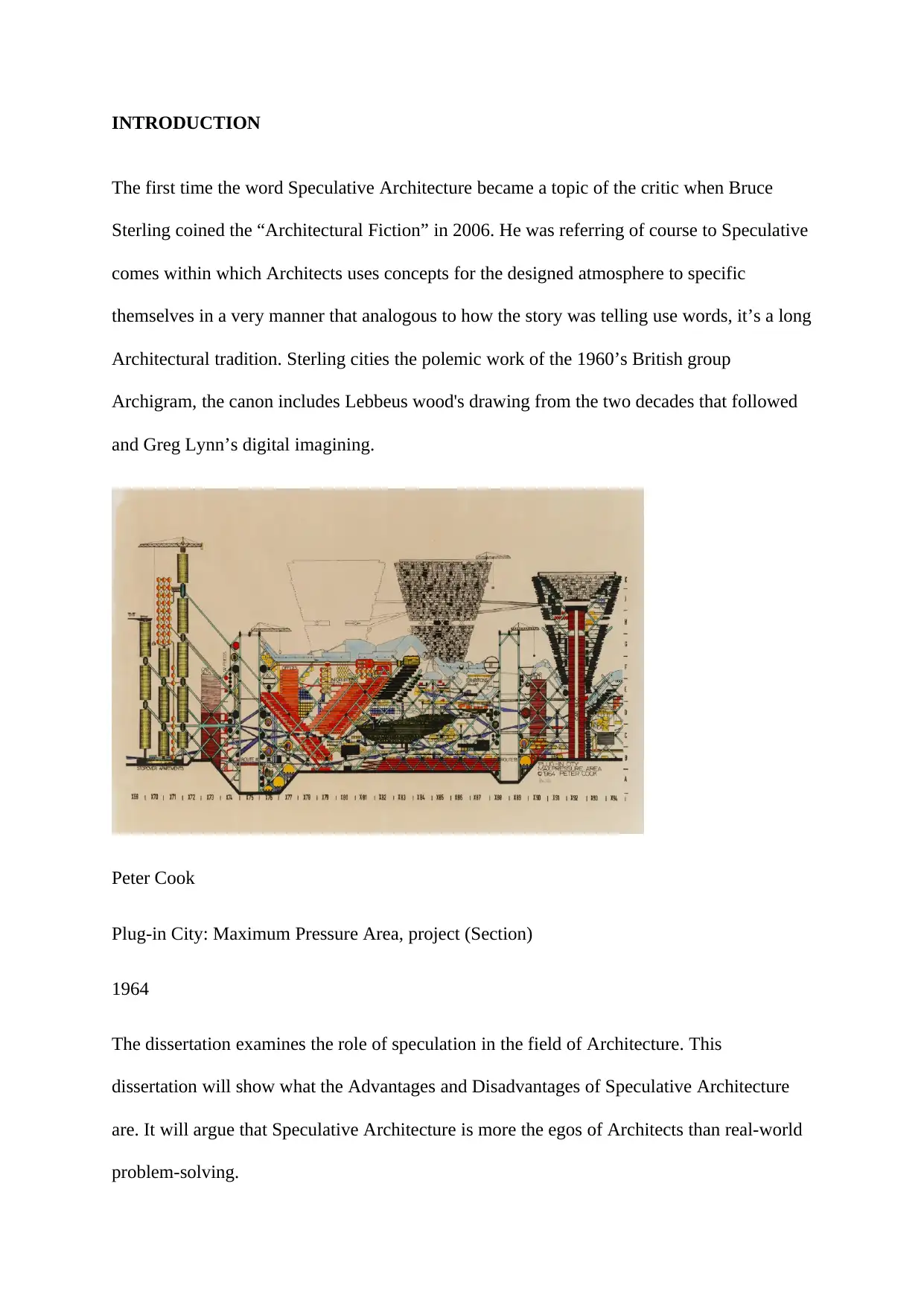
The first time the word Speculative Architecture became a topic of the critic when Bruce
Sterling coined the “Architectural Fiction” in 2006. He was referring of course to Speculative
comes within which Architects uses concepts for the designed atmosphere to specific
themselves in a very manner that analogous to how the story was telling use words, it’s a long
Architectural tradition. Sterling cities the polemic work of the 1960’s British group
Archigram, the canon includes Lebbeus wood's drawing from the two decades that followed
and Greg Lynn’s digital imagining.
Peter Cook
Plug-in City: Maximum Pressure Area, project (Section)
1964
The dissertation examines the role of speculation in the field of Architecture. This
dissertation will show what the Advantages and Disadvantages of Speculative Architecture
are. It will argue that Speculative Architecture is more the egos of Architects than real-world
problem-solving.
⊘ This is a preview!⊘
Do you want full access?
Subscribe today to unlock all pages.

Trusted by 1+ million students worldwide
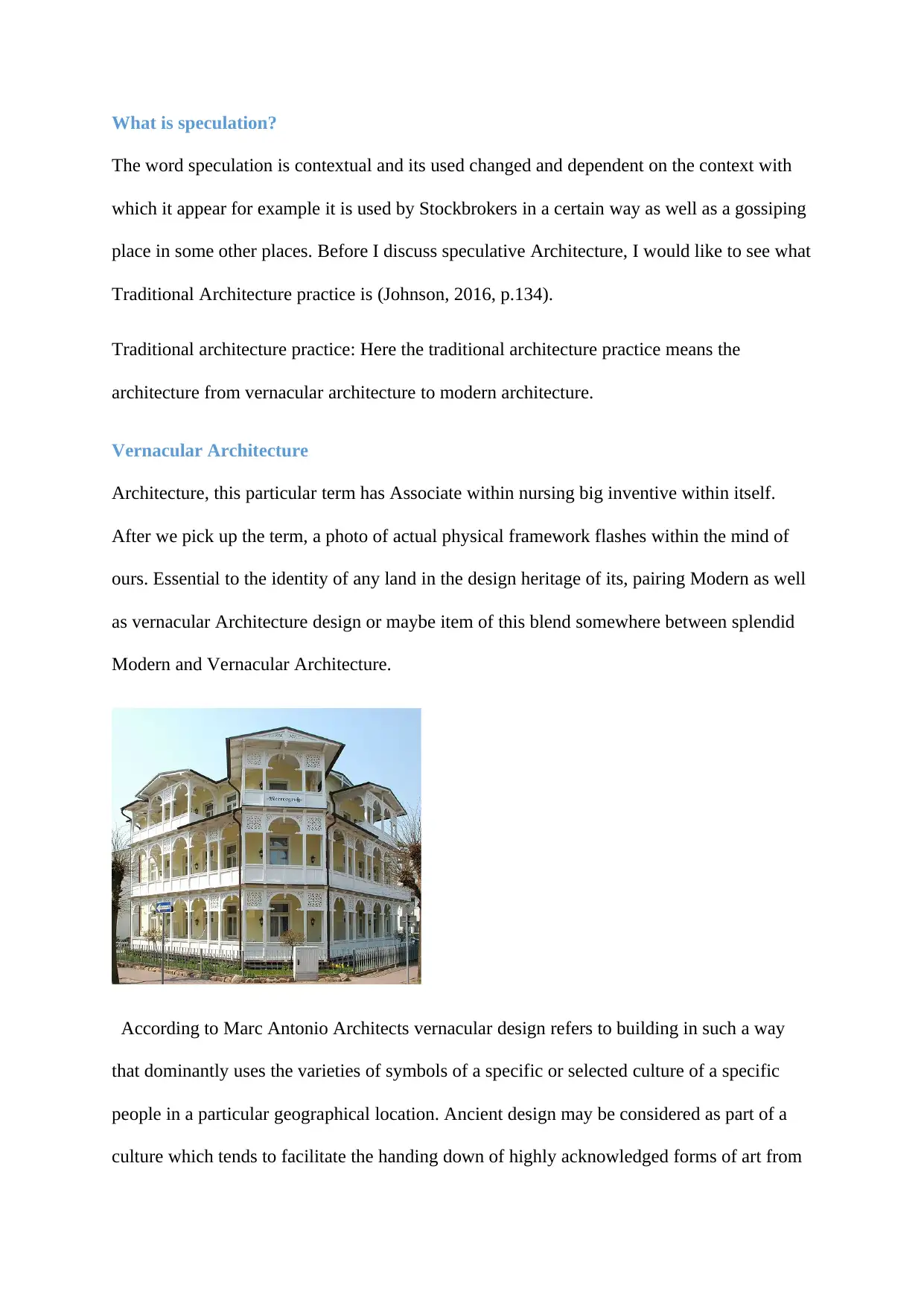
The word speculation is contextual and its used changed and dependent on the context with
which it appear for example it is used by Stockbrokers in a certain way as well as a gossiping
place in some other places. Before I discuss speculative Architecture, I would like to see what
Traditional Architecture practice is (Johnson, 2016, p.134).
Traditional architecture practice: Here the traditional architecture practice means the
architecture from vernacular architecture to modern architecture.
Vernacular Architecture
Architecture, this particular term has Associate within nursing big inventive within itself.
After we pick up the term, a photo of actual physical framework flashes within the mind of
ours. Essential to the identity of any land in the design heritage of its, pairing Modern as well
as vernacular Architecture design or maybe item of this blend somewhere between splendid
Modern and Vernacular Architecture.
According to Marc Antonio Architects vernacular design refers to building in such a way
that dominantly uses the varieties of symbols of a specific or selected culture of a specific
people in a particular geographical location. Ancient design may be considered as part of a
culture which tends to facilitate the handing down of highly acknowledged forms of art from
Paraphrase This Document
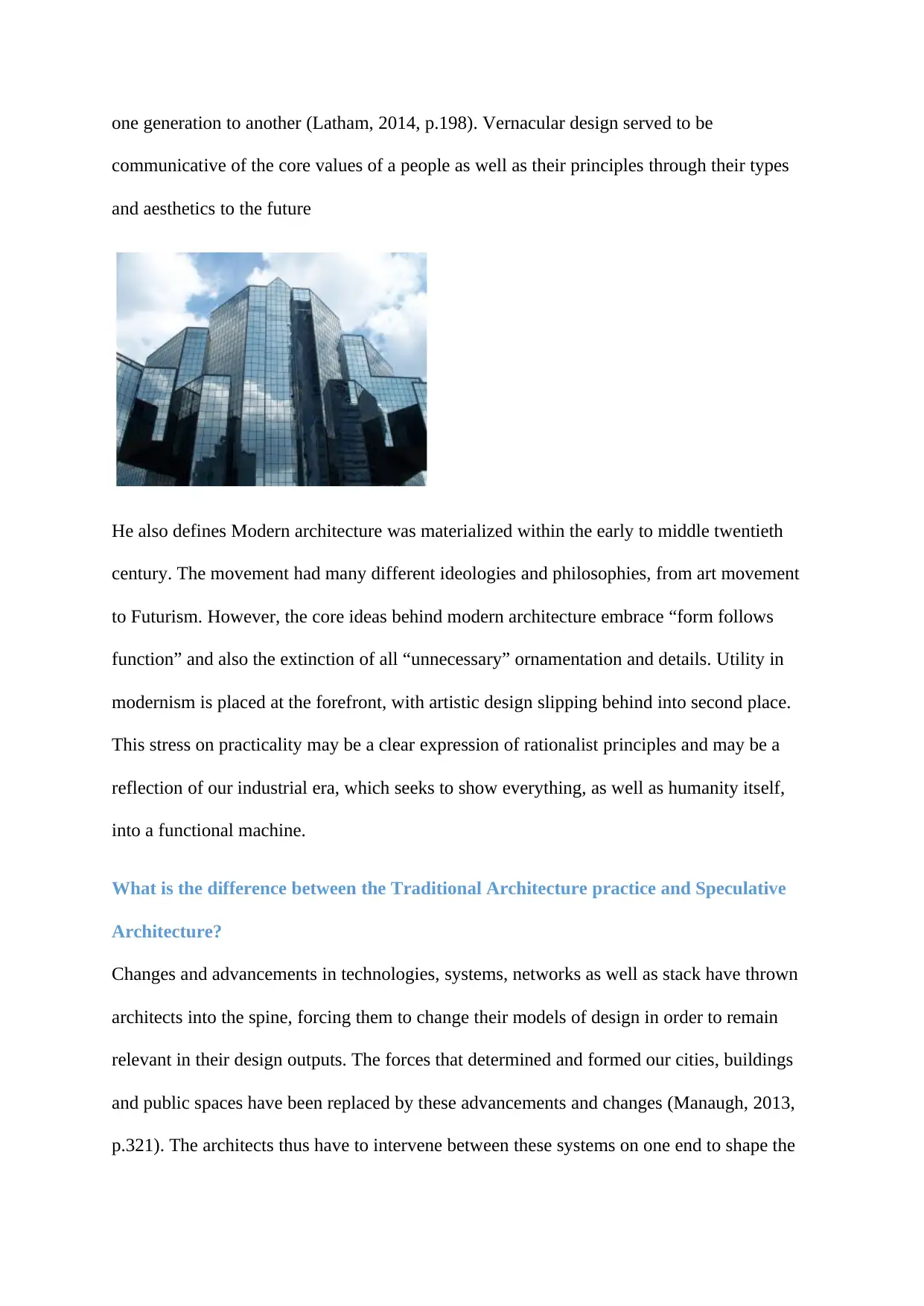
communicative of the core values of a people as well as their principles through their types
and aesthetics to the future
He also defines Modern architecture was materialized within the early to middle twentieth
century. The movement had many different ideologies and philosophies, from art movement
to Futurism. However, the core ideas behind modern architecture embrace “form follows
function” and also the extinction of all “unnecessary” ornamentation and details. Utility in
modernism is placed at the forefront, with artistic design slipping behind into second place.
This stress on practicality may be a clear expression of rationalist principles and may be a
reflection of our industrial era, which seeks to show everything, as well as humanity itself,
into a functional machine.
What is the difference between the Traditional Architecture practice and Speculative
Architecture?
Changes and advancements in technologies, systems, networks as well as stack have thrown
architects into the spine, forcing them to change their models of design in order to remain
relevant in their design outputs. The forces that determined and formed our cities, buildings
and public spaces have been replaced by these advancements and changes (Manaugh, 2013,
p.321). The architects thus have to intervene between these systems on one end to shape the

making the very buildings and cities. Speculative architecture is about making narrations ion
how cities and buildings operate and speculative architects largely generate stories explaining
how the cities and buildings operate, the new technologies and their influence on the
community, culture and space. They are tasked with locating the places of existence of new
forms of technology within the contexts of the cities which have experienced changes and
transformations due to these developments. These're speculative tasks which haven't been
legitimized within the profession. However, structure entails an extended heritage of unbuilt
comes in case we are likely to carry a look at the timeline of speculative tasks arrives around
the globe.
⊘ This is a preview!⊘
Do you want full access?
Subscribe today to unlock all pages.

Trusted by 1+ million students worldwide

Since the 1960s, a variety of irreverent ‘speculative designers’ started Working against the
homogenizing interests of massive business these ‘speculative designers’ have explored the
potential of such emancipated observe. Their activities are unit typified by a liberated
approach to the outcome or product. They are released to use style instead of as an inquiry
tool – a vehicle to unlock new ideas instead of new markets Free from the duty to supply
some commercially viable ‘thing.’
Frank Lloyd Wright-1954
A dream city was one of the final ideas of Lloyd Wright. Ellis Island was a prediction of the
key to freedom as well as an opportunity to respond to numerous little questions that were
desired to make the greatest out of the name of Wright (Trezise, 2014, p.451). Regardless of
the then prevailing challenging circumstances, a declaration was made to construct what is
currently the defunct immigration center by Damon and Doudt firm, a highly self-contained
city of the future which was designed by the late Frank Wright. The construction of the city
was estimated to be $100,000,000 which is about $810,374,172.19 at the current value of the
dollar.
Paraphrase This Document

Plans by architect, systems intellect, author, designer and artificer Richard Buckminster
Fuller represented a three-kilometre (1.864-mile) dome spanning Midtown Manhattan It
sounds utterly absurd now, however within the time, engineers and futurists hoped to cover
Midtown Manhattan with a large dome. With the aim of control weather and reducing
pollution, the structure would have stretched from the strait to The Hudson River and from
the twenty-first Street to sixty-fourth Street. Its edges would have enclosed reducing cooling
costs in summer and heating costs within the winter. In fact, buildings would now not want
separate heating or cooling because the dome would regulate the temperature.
Archigram – 1960-2003

Cook, Dennis Crompton, David author, West Chadic Herron and electro-acoustic transducer
Webb, had been printed throughout the planetPlug-In town is one amongst the primary
megastructures planned by Archigram. The project incorporates notions 1st developed in City
Interchange concerning channelling traffic, info, and support systems, however inside
Associate in Nursing urban setting where people live and work (Johnson, 2016, p.365). Plug-
In town consists of a network of access ways in which to transportation and essential
services, like electricity, plumbing, and heating, upon that housing and industrial modules are
connected via a system of service cranes. The structure is hollow and multi-layered,
supported the archetypical medieval town wall.
Victor Gruen-1961
Nearly engineered a large development on what's currently known as Roosevelt Island.
Responding to mass housing shortages, the project would have accommodated up to 7000
people. The project would have comprised a twenty-two foot tall, a two-level platform with a
series of eight to 50-story flat towers. The architect knew because of the creator of the
fashionable shopping center.
⊘ This is a preview!⊘
Do you want full access?
Subscribe today to unlock all pages.

Trusted by 1+ million students worldwide
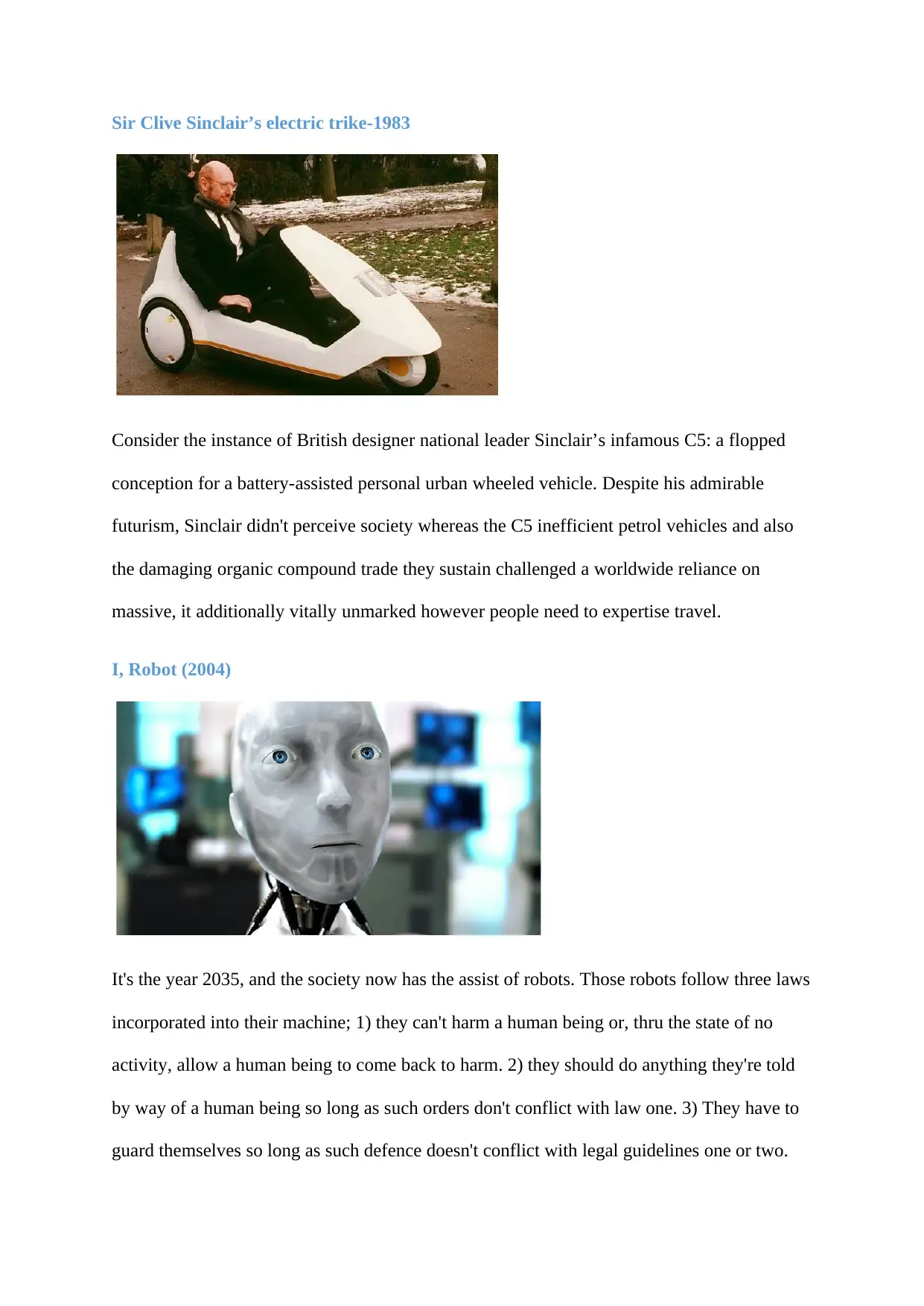
Consider the instance of British designer national leader Sinclair’s infamous C5: a flopped
conception for a battery-assisted personal urban wheeled vehicle. Despite his admirable
futurism, Sinclair didn't perceive society whereas the C5 inefficient petrol vehicles and also
the damaging organic compound trade they sustain challenged a worldwide reliance on
massive, it additionally vitally unmarked however people need to expertise travel.
I, Robot (2004)
It's the year 2035, and the society now has the assist of robots. Those robots follow three laws
incorporated into their machine; 1) they can't harm a human being or, thru the state of no
activity, allow a human being to come back to harm. 2) they should do anything they're told
by way of a human being so long as such orders don't conflict with law one. 3) They have to
guard themselves so long as such defence doesn't conflict with legal guidelines one or two.
Paraphrase This Document

US. Robotics. The majority of the Chicago police department agree with he devoted to
suicide, but detective Del Spooner, who hates robots, thinks he became murdered, and the
primary suspect is a robot who calls himself sonny. However, if it turned into sonny, then its
method he might've had to have broken the three laws. With the assist of dr. Susan Calvin,
Spooner ought to now discover the fact earlier than it's too late. A technophobic cop
investigates a crime that may have been perpetrated by a robot, which leads to a larger threat
to humanity (Johnson, 2016, p.117).
Where the City Can’t See- Liam Young – 2017
When a City Can’t See is a world’s narrative fiction that was shot using optical master
scanner and set within the hands of the Chinese under the control of the Economic Zone city
The constant scanning technologies that was used in shooting the film were those employed
in autonomous vehicles in which a record through the eyes of the robots that manage the city
is done of the close to future town. During a driverless taxi, a gaggle of young employees
drifts into the city on one night. These gaggles of young employees were out to establish an
area that they acknowledge existed but was not recognized by their automobile. This group is
part of an Associate in the community that was on the assembly lines during the day and
adorn themselves during the night into machine vision camouflage. This very group of
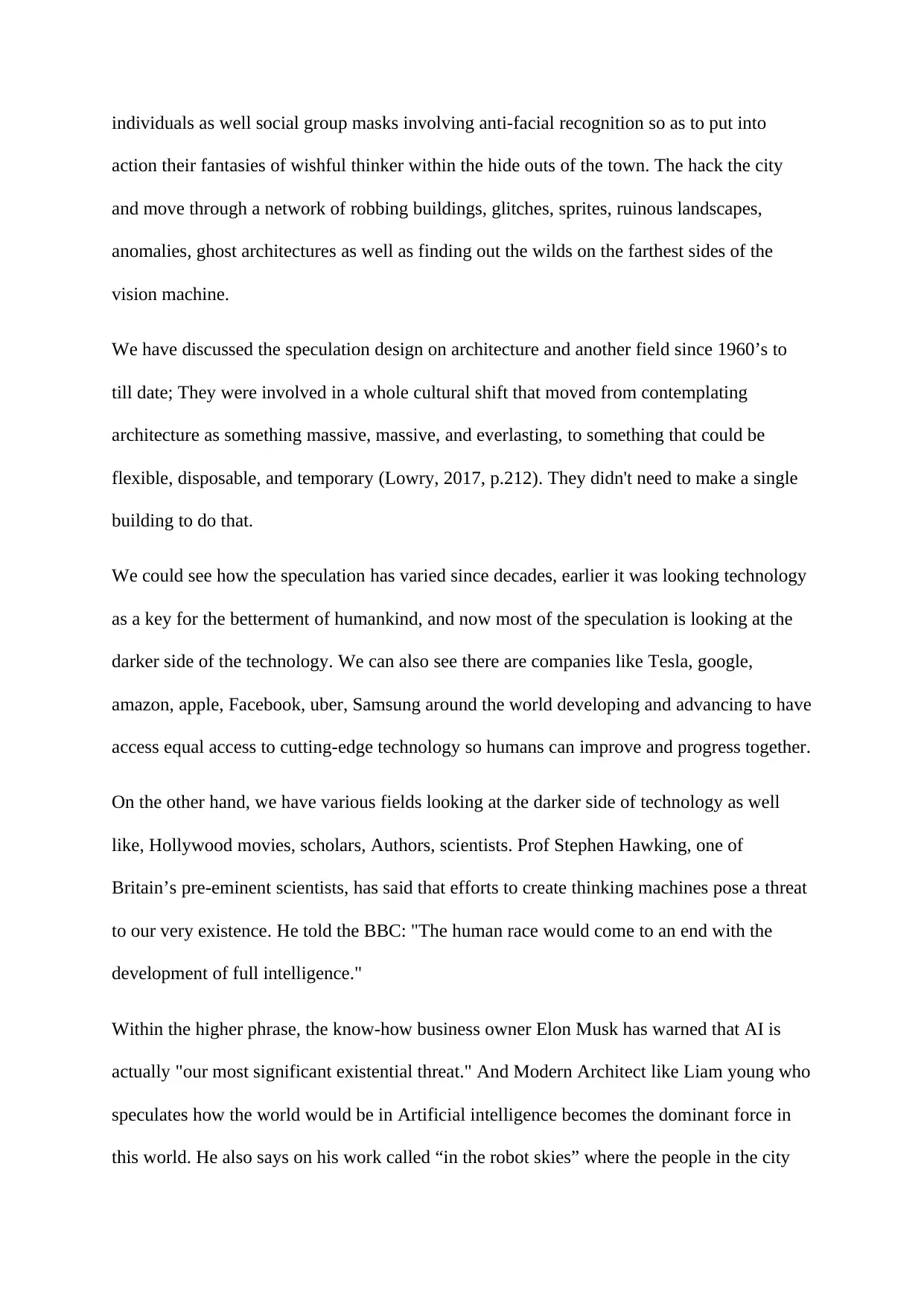
action their fantasies of wishful thinker within the hide outs of the town. The hack the city
and move through a network of robbing buildings, glitches, sprites, ruinous landscapes,
anomalies, ghost architectures as well as finding out the wilds on the farthest sides of the
vision machine.
We have discussed the speculation design on architecture and another field since 1960’s to
till date; They were involved in a whole cultural shift that moved from contemplating
architecture as something massive, massive, and everlasting, to something that could be
flexible, disposable, and temporary (Lowry, 2017, p.212). They didn't need to make a single
building to do that.
We could see how the speculation has varied since decades, earlier it was looking technology
as a key for the betterment of humankind, and now most of the speculation is looking at the
darker side of the technology. We can also see there are companies like Tesla, google,
amazon, apple, Facebook, uber, Samsung around the world developing and advancing to have
access equal access to cutting-edge technology so humans can improve and progress together.
On the other hand, we have various fields looking at the darker side of technology as well
like, Hollywood movies, scholars, Authors, scientists. Prof Stephen Hawking, one of
Britain’s pre-eminent scientists, has said that efforts to create thinking machines pose a threat
to our very existence. He told the BBC: "The human race would come to an end with the
development of full intelligence."
Within the higher phrase, the know-how business owner Elon Musk has warned that AI is
actually "our most significant existential threat." And Modern Architect like Liam young who
speculates how the world would be in Artificial intelligence becomes the dominant force in
this world. He also says on his work called “in the robot skies” where the people in the city
⊘ This is a preview!⊘
Do you want full access?
Subscribe today to unlock all pages.

Trusted by 1+ million students worldwide
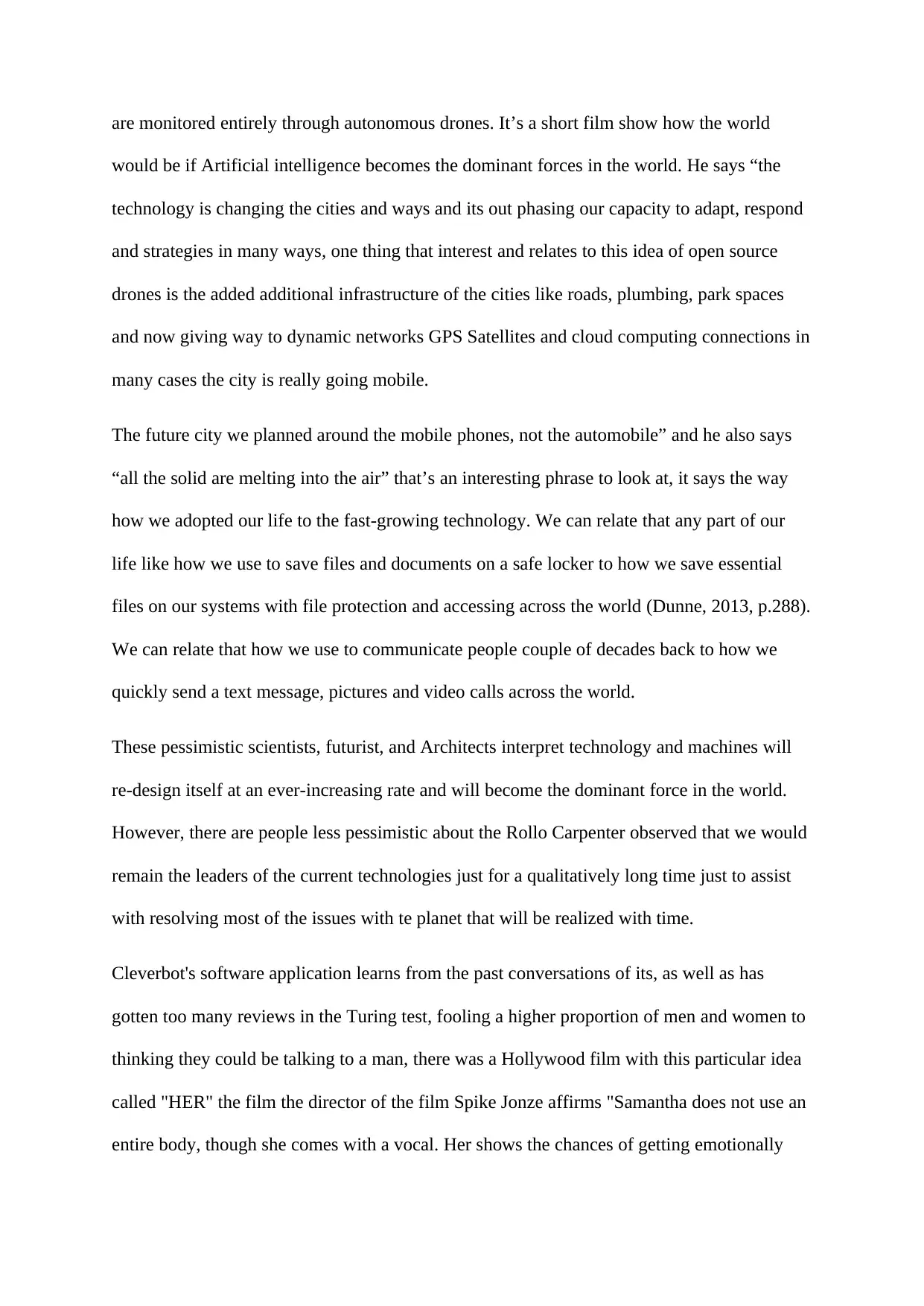
would be if Artificial intelligence becomes the dominant forces in the world. He says “the
technology is changing the cities and ways and its out phasing our capacity to adapt, respond
and strategies in many ways, one thing that interest and relates to this idea of open source
drones is the added additional infrastructure of the cities like roads, plumbing, park spaces
and now giving way to dynamic networks GPS Satellites and cloud computing connections in
many cases the city is really going mobile.
The future city we planned around the mobile phones, not the automobile” and he also says
“all the solid are melting into the air” that’s an interesting phrase to look at, it says the way
how we adopted our life to the fast-growing technology. We can relate that any part of our
life like how we use to save files and documents on a safe locker to how we save essential
files on our systems with file protection and accessing across the world (Dunne, 2013, p.288).
We can relate that how we use to communicate people couple of decades back to how we
quickly send a text message, pictures and video calls across the world.
These pessimistic scientists, futurist, and Architects interpret technology and machines will
re-design itself at an ever-increasing rate and will become the dominant force in the world.
However, there are people less pessimistic about the Rollo Carpenter observed that we would
remain the leaders of the current technologies just for a qualitatively long time just to assist
with resolving most of the issues with te planet that will be realized with time.
Cleverbot's software application learns from the past conversations of its, as well as has
gotten too many reviews in the Turing test, fooling a higher proportion of men and women to
thinking they could be talking to a man, there was a Hollywood film with this particular idea
called "HER" the film the director of the film Spike Jonze affirms "Samantha does not use an
entire body, though she comes with a vocal. Her shows the chances of getting emotionally
Paraphrase This Document
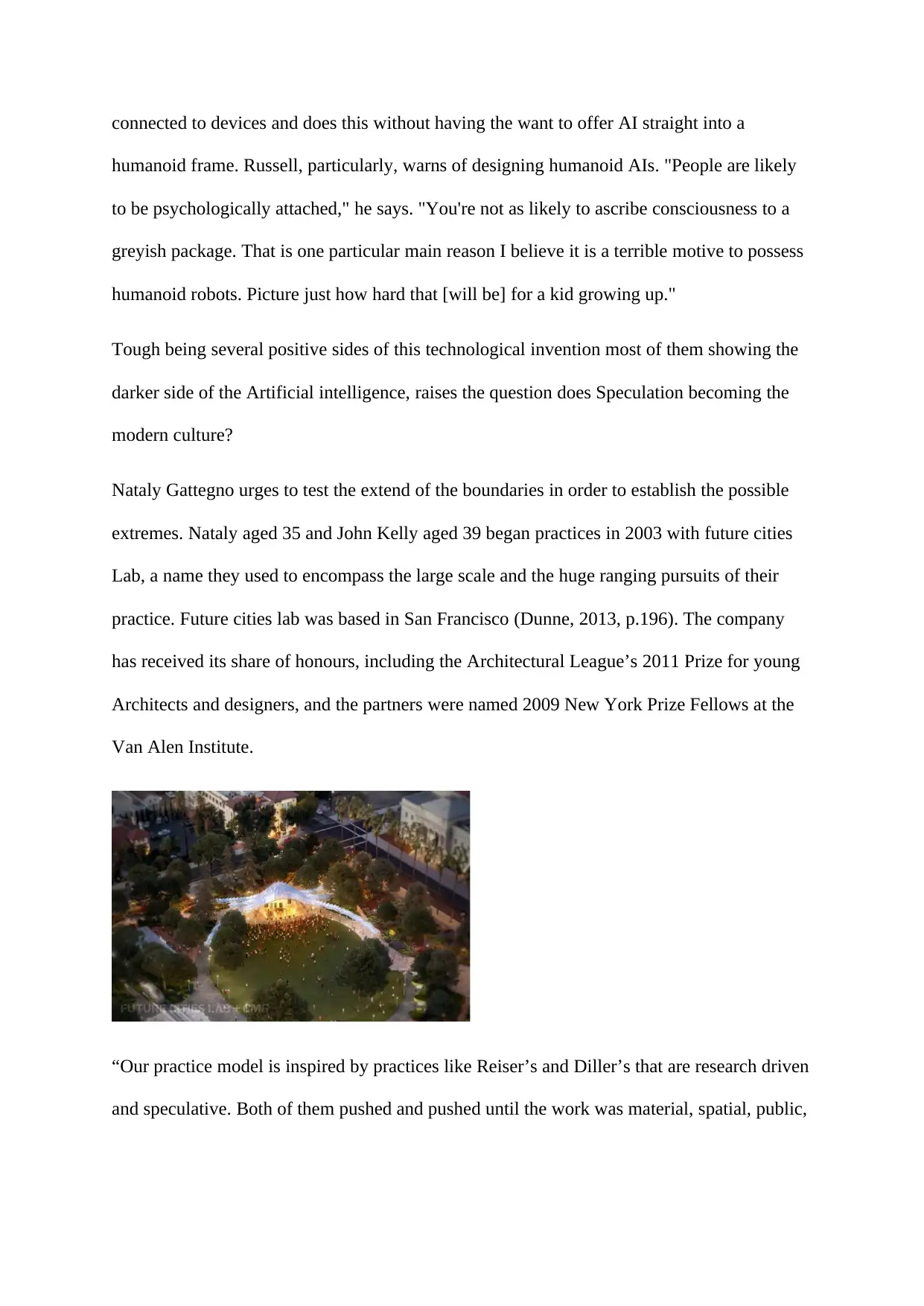
humanoid frame. Russell, particularly, warns of designing humanoid AIs. "People are likely
to be psychologically attached," he says. "You're not as likely to ascribe consciousness to a
greyish package. That is one particular main reason I believe it is a terrible motive to possess
humanoid robots. Picture just how hard that [will be] for a kid growing up."
Tough being several positive sides of this technological invention most of them showing the
darker side of the Artificial intelligence, raises the question does Speculation becoming the
modern culture?
Nataly Gattegno urges to test the extend of the boundaries in order to establish the possible
extremes. Nataly aged 35 and John Kelly aged 39 began practices in 2003 with future cities
Lab, a name they used to encompass the large scale and the huge ranging pursuits of their
practice. Future cities lab was based in San Francisco (Dunne, 2013, p.196). The company
has received its share of honours, including the Architectural League’s 2011 Prize for young
Architects and designers, and the partners were named 2009 New York Prize Fellows at the
Van Alen Institute.
“Our practice model is inspired by practices like Reiser’s and Diller’s that are research driven
and speculative. Both of them pushed and pushed until the work was material, spatial, public,

architecture,” Johnson says
Modern culture includes the spectacle of speculation, which turns out to be a figure of
showing, rather than of seeing ( a future to come). Speculation as a field of subjective
strategies of difference occurs within economic theory, where the spectacular speculator has
to act against the mass.
Speculation can be understood as subjective manipulation of values to evaluate them. It’s
strategies of different that provoke the break and provide the new contract to the old. Old that
is best shown in the classic modern architecture of the 1920’s does not mean antiquity, but
directly preceding fashion, in this case, the fashion of art nouveau. In the sixties, there's
simply no questioning the point any longer which contemporary way of life is all about the
speculate. In the program of time, the contents have transformed from modernist vast open
lamentation to ironic tries of subversion; the techniques, nonetheless, stay speculative. They
are made up of the constant, trendy revaluation of values (Nemirovsky, 2013, p.215). In
modern art and architecture, this strategy is linked to the Avant- grade. We call it anti-design
or anti-fashion since the aim at difference continually makes the author negate established
positions.
Of course, fashion is not restricted to the practice fields of culture, but also extends to
theoretical and curatorial discourses. The collection, presentation, and discussion of others
works are themselves works, embodying the aim of an author at becoming spectacular. They
are also forms of speculation, which is always strategic or medial, not only stating. Again: it
is a matter of showing, rather than just seeing. It is a matter of fashion and anti-fashion.
What is the relationship between speculation in another field of Architecture?
⊘ This is a preview!⊘
Do you want full access?
Subscribe today to unlock all pages.

Trusted by 1+ million students worldwide
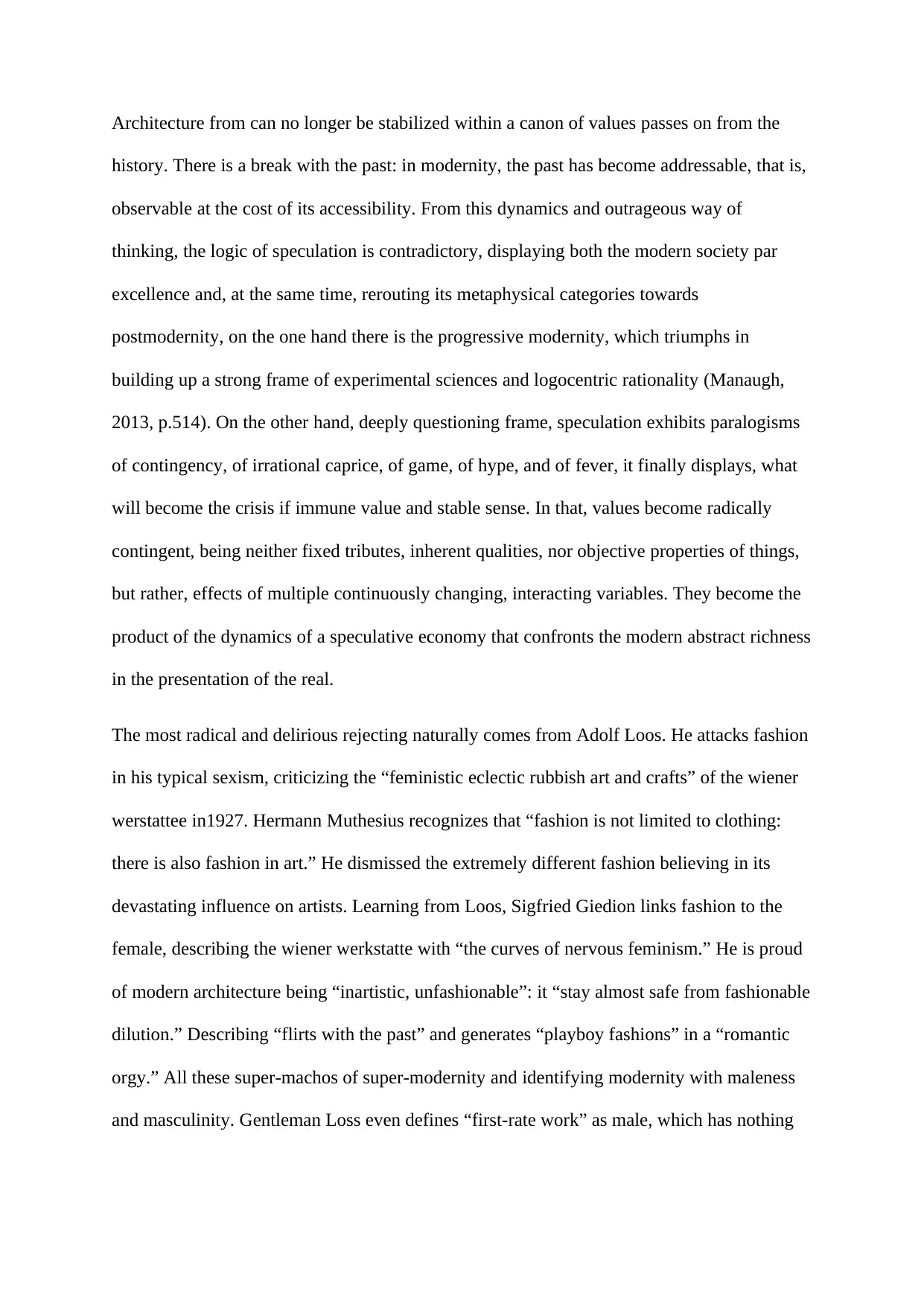
history. There is a break with the past: in modernity, the past has become addressable, that is,
observable at the cost of its accessibility. From this dynamics and outrageous way of
thinking, the logic of speculation is contradictory, displaying both the modern society par
excellence and, at the same time, rerouting its metaphysical categories towards
postmodernity, on the one hand there is the progressive modernity, which triumphs in
building up a strong frame of experimental sciences and logocentric rationality (Manaugh,
2013, p.514). On the other hand, deeply questioning frame, speculation exhibits paralogisms
of contingency, of irrational caprice, of game, of hype, and of fever, it finally displays, what
will become the crisis if immune value and stable sense. In that, values become radically
contingent, being neither fixed tributes, inherent qualities, nor objective properties of things,
but rather, effects of multiple continuously changing, interacting variables. They become the
product of the dynamics of a speculative economy that confronts the modern abstract richness
in the presentation of the real.
The most radical and delirious rejecting naturally comes from Adolf Loos. He attacks fashion
in his typical sexism, criticizing the “feministic eclectic rubbish art and crafts” of the wiener
werstattee in1927. Hermann Muthesius recognizes that “fashion is not limited to clothing:
there is also fashion in art.” He dismissed the extremely different fashion believing in its
devastating influence on artists. Learning from Loos, Sigfried Giedion links fashion to the
female, describing the wiener werkstatte with “the curves of nervous feminism.” He is proud
of modern architecture being “inartistic, unfashionable”: it “stay almost safe from fashionable
dilution.” Describing “flirts with the past” and generates “playboy fashions” in a “romantic
orgy.” All these super-machos of super-modernity and identifying modernity with maleness
and masculinity. Gentleman Loss even defines “first-rate work” as male, which has nothing
Paraphrase This Document

rail-wasting daughters of senior civil servants or another fraulein”.
Instead of working in the field of seminarian figures of dressing, undressing, and surface of
the culture critical approaches, we will investigate fashion as a general economy of values
and change.
viktor and rolf s/s 08 show, Paris
https://www.designscene.net/2007/11/fashion-show-venues.html
veronique branquinho a/w 09/10
https://ashadedviewonfashion.com/2009/01/24/paris-men-fallwinter-0910-by-shoji-fujii-
veronique-branquinho/
Georg Simmel gives an introduction to fashion, which considers fashion beyond clothes. He
recognizes fashion as a broad social phenomenon, whose dynamic processes also appear in
areas of life other than clothing (Johnson, 2016, p.218). "Indeed, it's practically a symbol of
the greater strength of style that it's overstepped the bounds of the original domain of its, that
comprised simply externals of dress, as well as has acquired an increasing effect oversample,
the theoretical convictions as well as the moral foundations of daily life in their changing
kinds. Disregarding the typical talk of fashion 's content, Simmel, thus, investigates its
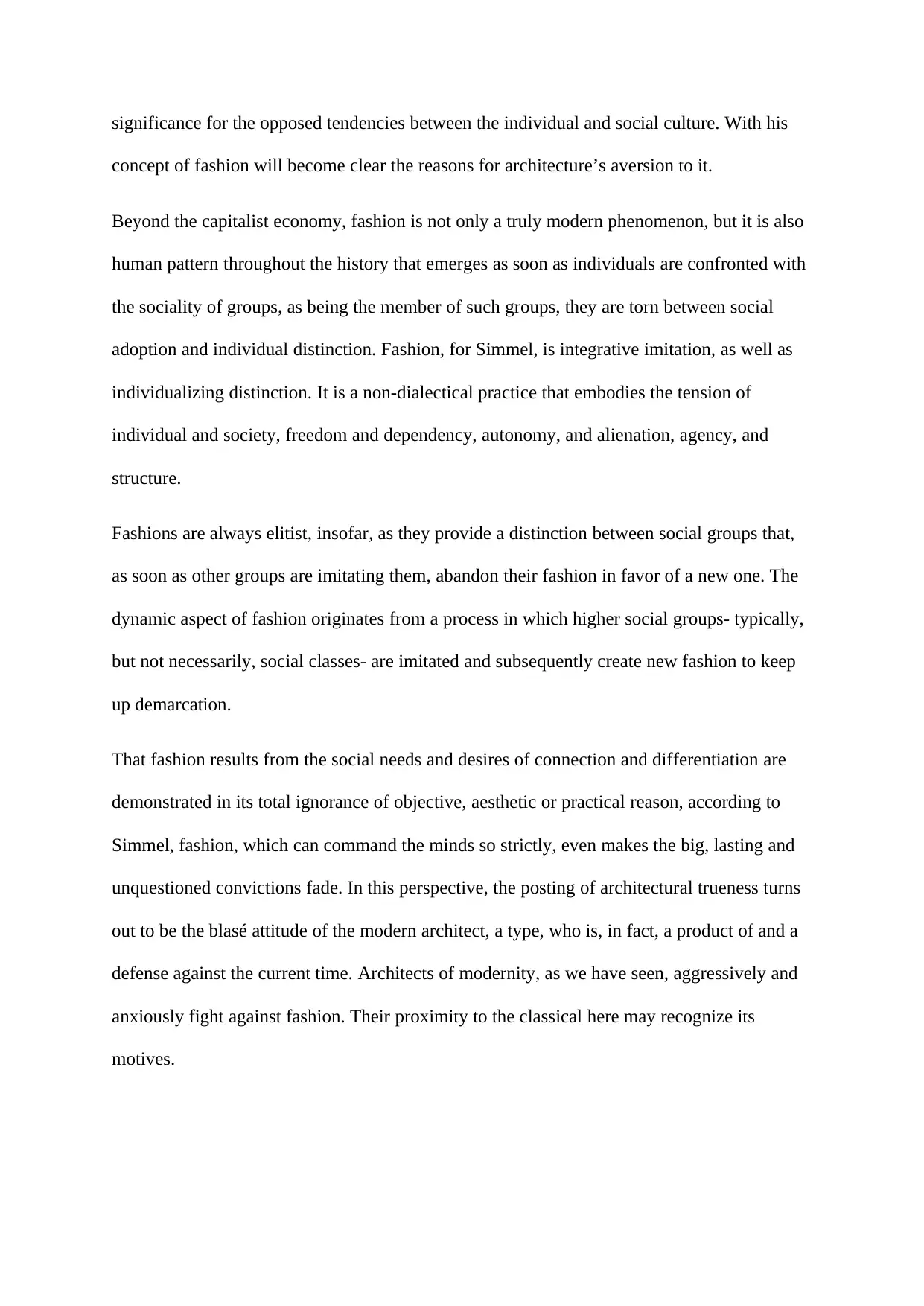
concept of fashion will become clear the reasons for architecture’s aversion to it.
Beyond the capitalist economy, fashion is not only a truly modern phenomenon, but it is also
human pattern throughout the history that emerges as soon as individuals are confronted with
the sociality of groups, as being the member of such groups, they are torn between social
adoption and individual distinction. Fashion, for Simmel, is integrative imitation, as well as
individualizing distinction. It is a non-dialectical practice that embodies the tension of
individual and society, freedom and dependency, autonomy, and alienation, agency, and
structure.
Fashions are always elitist, insofar, as they provide a distinction between social groups that,
as soon as other groups are imitating them, abandon their fashion in favor of a new one. The
dynamic aspect of fashion originates from a process in which higher social groups- typically,
but not necessarily, social classes- are imitated and subsequently create new fashion to keep
up demarcation.
That fashion results from the social needs and desires of connection and differentiation are
demonstrated in its total ignorance of objective, aesthetic or practical reason, according to
Simmel, fashion, which can command the minds so strictly, even makes the big, lasting and
unquestioned convictions fade. In this perspective, the posting of architectural trueness turns
out to be the blasé attitude of the modern architect, a type, who is, in fact, a product of and a
defense against the current time. Architects of modernity, as we have seen, aggressively and
anxiously fight against fashion. Their proximity to the classical here may recognize its
motives.
⊘ This is a preview!⊘
Do you want full access?
Subscribe today to unlock all pages.

Trusted by 1+ million students worldwide

iannis-xenakis
lanvin Castillo coat
Let us have some modern examples
"If the professional life of ours had been constrained by the task of materials and regulatory
bodies and contractors, we would miss the bigger point of what we do," stated Byron Kuth of
Kuth/Ranieri Architects,
Millennial Falls
San Francisco, CA
Paraphrase This Document
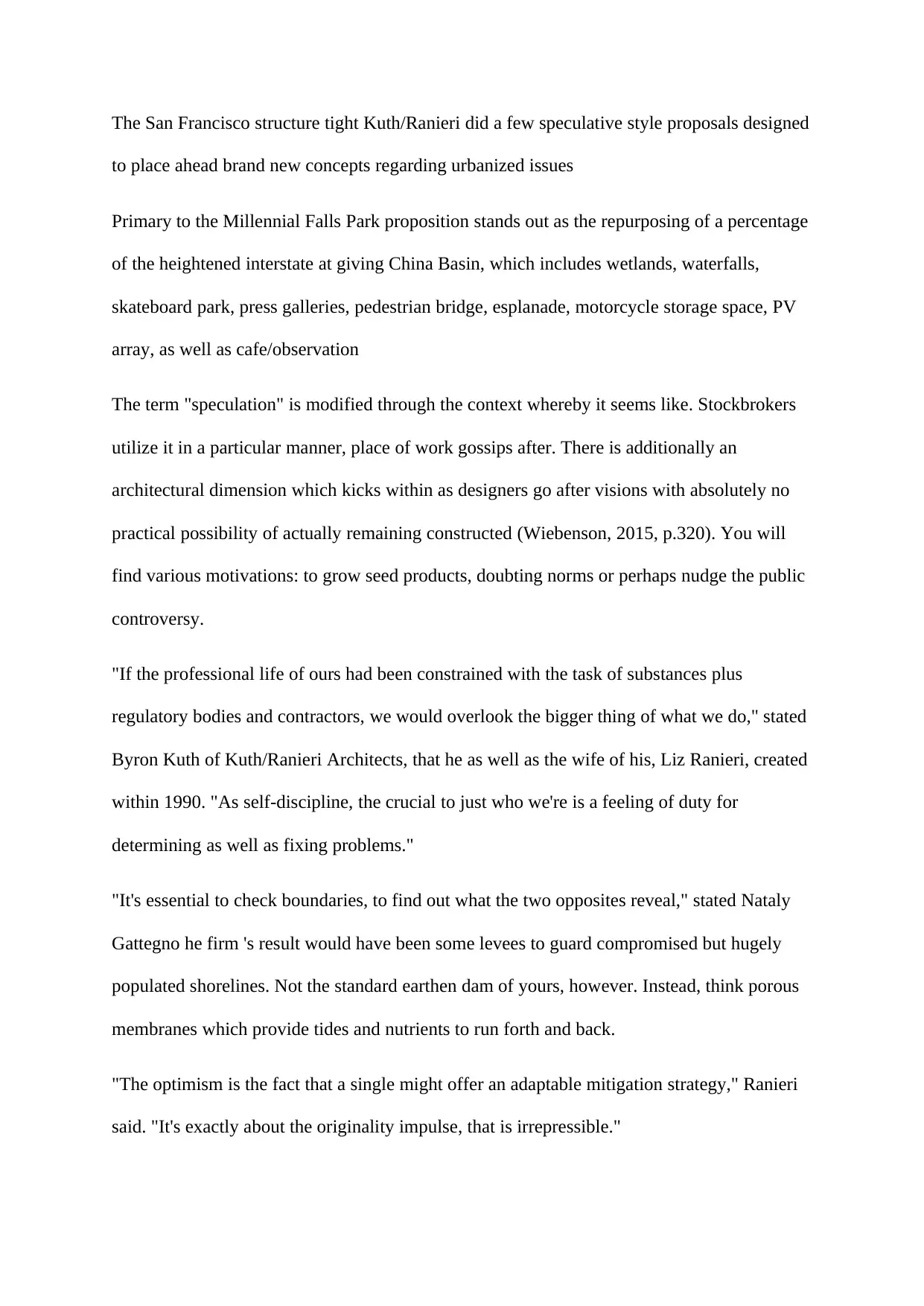
to place ahead brand new concepts regarding urbanized issues
Primary to the Millennial Falls Park proposition stands out as the repurposing of a percentage
of the heightened interstate at giving China Basin, which includes wetlands, waterfalls,
skateboard park, press galleries, pedestrian bridge, esplanade, motorcycle storage space, PV
array, as well as cafe/observation
The term "speculation" is modified through the context whereby it seems like. Stockbrokers
utilize it in a particular manner, place of work gossips after. There is additionally an
architectural dimension which kicks within as designers go after visions with absolutely no
practical possibility of actually remaining constructed (Wiebenson, 2015, p.320). You will
find various motivations: to grow seed products, doubting norms or perhaps nudge the public
controversy.
"If the professional life of ours had been constrained with the task of substances plus
regulatory bodies and contractors, we would overlook the bigger thing of what we do," stated
Byron Kuth of Kuth/Ranieri Architects, that he as well as the wife of his, Liz Ranieri, created
within 1990. "As self-discipline, the crucial to just who we're is a feeling of duty for
determining as well as fixing problems."
"It's essential to check boundaries, to find out what the two opposites reveal," stated Nataly
Gattegno he firm 's result would have been some levees to guard compromised but hugely
populated shorelines. Not the standard earthen dam of yours, however. Instead, think porous
membranes which provide tides and nutrients to run forth and back.
"The optimism is the fact that a single might offer an adaptable mitigation strategy," Ranieri
said. "It's exactly about the originality impulse, that is irrepressible."
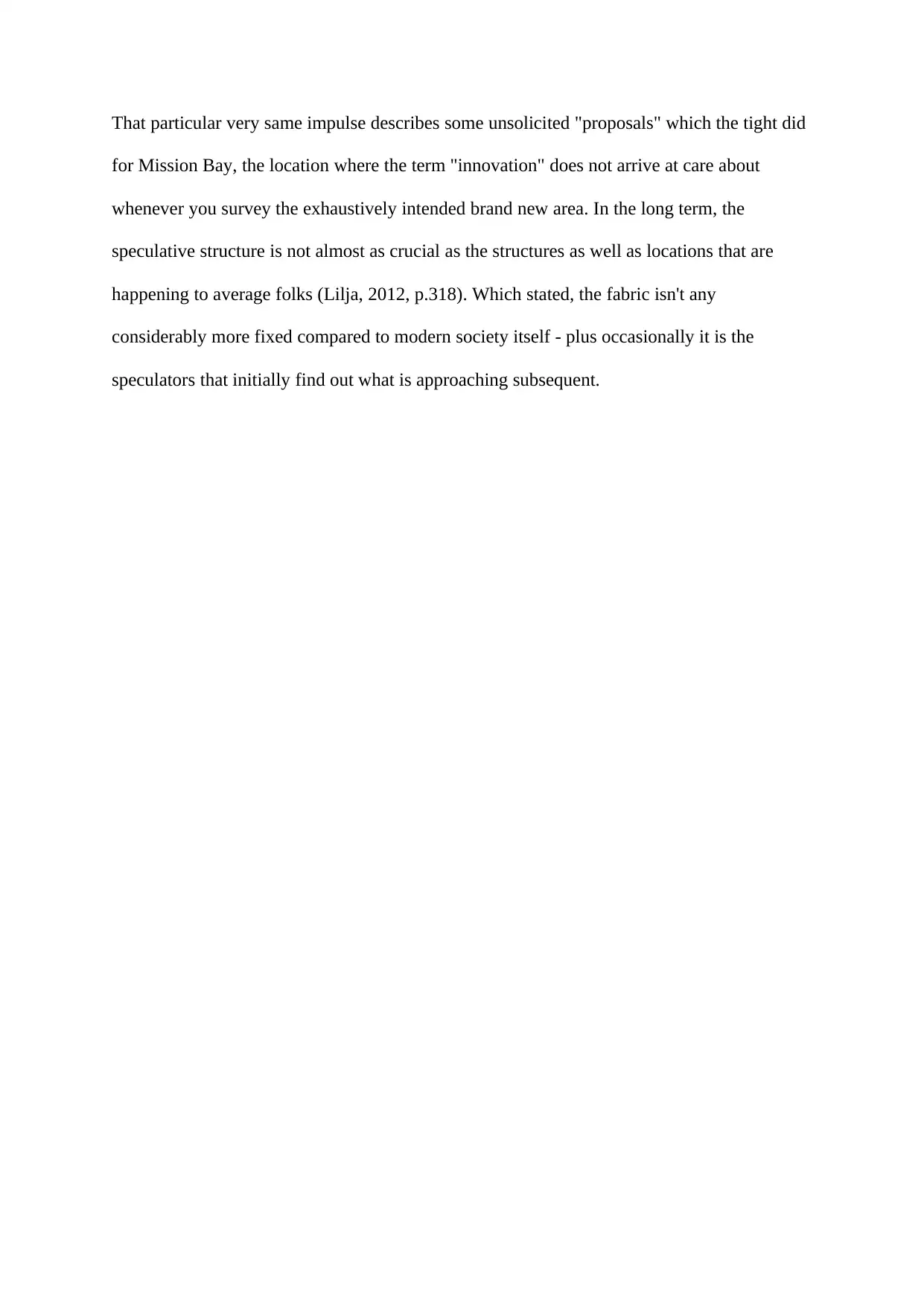
for Mission Bay, the location where the term "innovation" does not arrive at care about
whenever you survey the exhaustively intended brand new area. In the long term, the
speculative structure is not almost as crucial as the structures as well as locations that are
happening to average folks (Lilja, 2012, p.318). Which stated, the fabric isn't any
considerably more fixed compared to modern society itself - plus occasionally it is the
speculators that initially find out what is approaching subsequent.
⊘ This is a preview!⊘
Do you want full access?
Subscribe today to unlock all pages.

Trusted by 1+ million students worldwide
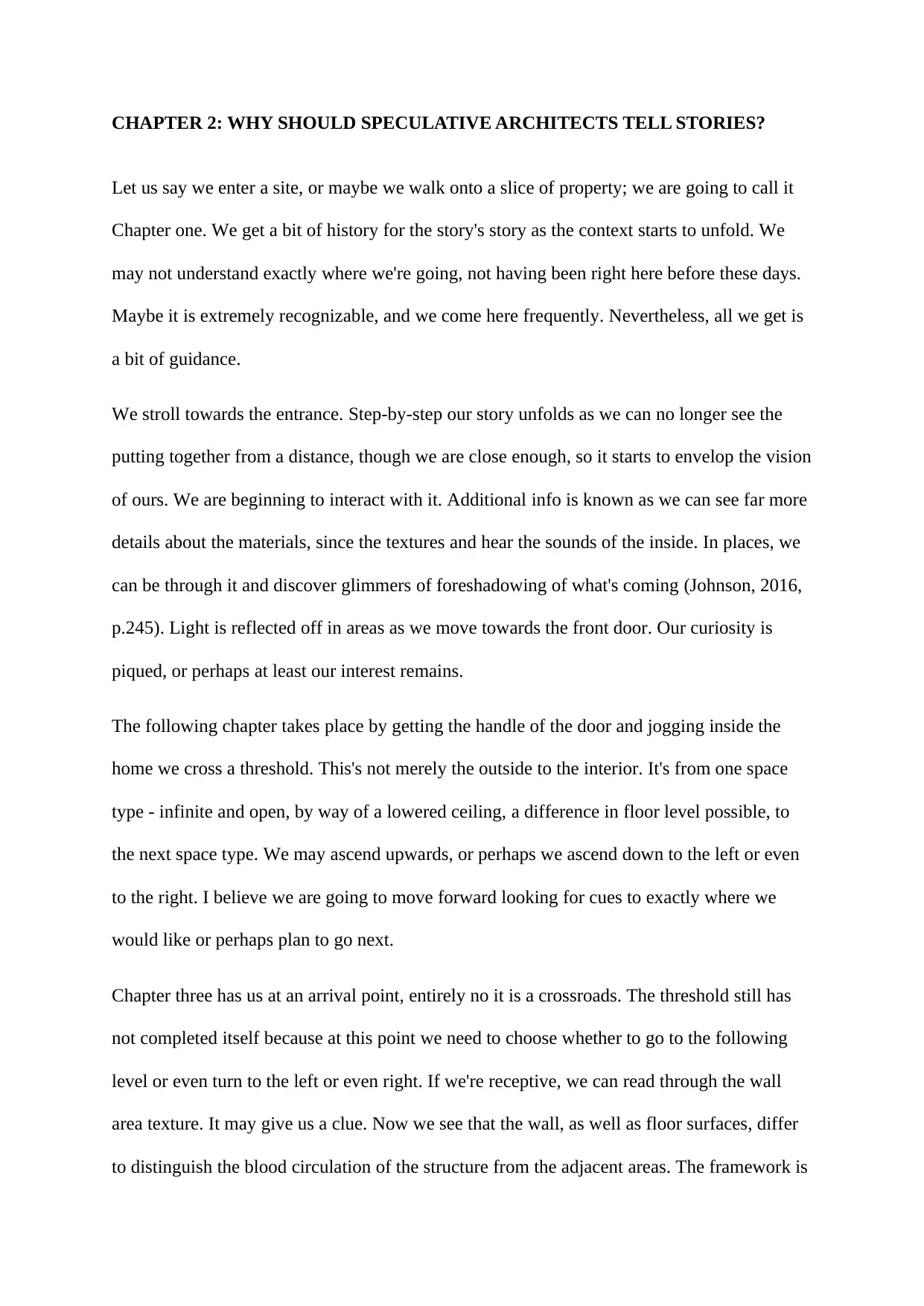
Let us say we enter a site, or maybe we walk onto a slice of property; we are going to call it
Chapter one. We get a bit of history for the story's story as the context starts to unfold. We
may not understand exactly where we're going, not having been right here before these days.
Maybe it is extremely recognizable, and we come here frequently. Nevertheless, all we get is
a bit of guidance.
We stroll towards the entrance. Step-by-step our story unfolds as we can no longer see the
putting together from a distance, though we are close enough, so it starts to envelop the vision
of ours. We are beginning to interact with it. Additional info is known as we can see far more
details about the materials, since the textures and hear the sounds of the inside. In places, we
can be through it and discover glimmers of foreshadowing of what's coming (Johnson, 2016,
p.245). Light is reflected off in areas as we move towards the front door. Our curiosity is
piqued, or perhaps at least our interest remains.
The following chapter takes place by getting the handle of the door and jogging inside the
home we cross a threshold. This's not merely the outside to the interior. It's from one space
type - infinite and open, by way of a lowered ceiling, a difference in floor level possible, to
the next space type. We may ascend upwards, or perhaps we ascend down to the left or even
to the right. I believe we are going to move forward looking for cues to exactly where we
would like or perhaps plan to go next.
Chapter three has us at an arrival point, entirely no it is a crossroads. The threshold still has
not completed itself because at this point we need to choose whether to go to the following
level or even turn to the left or even right. If we're receptive, we can read through the wall
area texture. It may give us a clue. Now we see that the wall, as well as floor surfaces, differ
to distinguish the blood circulation of the structure from the adjacent areas. The framework is
Paraphrase This Document
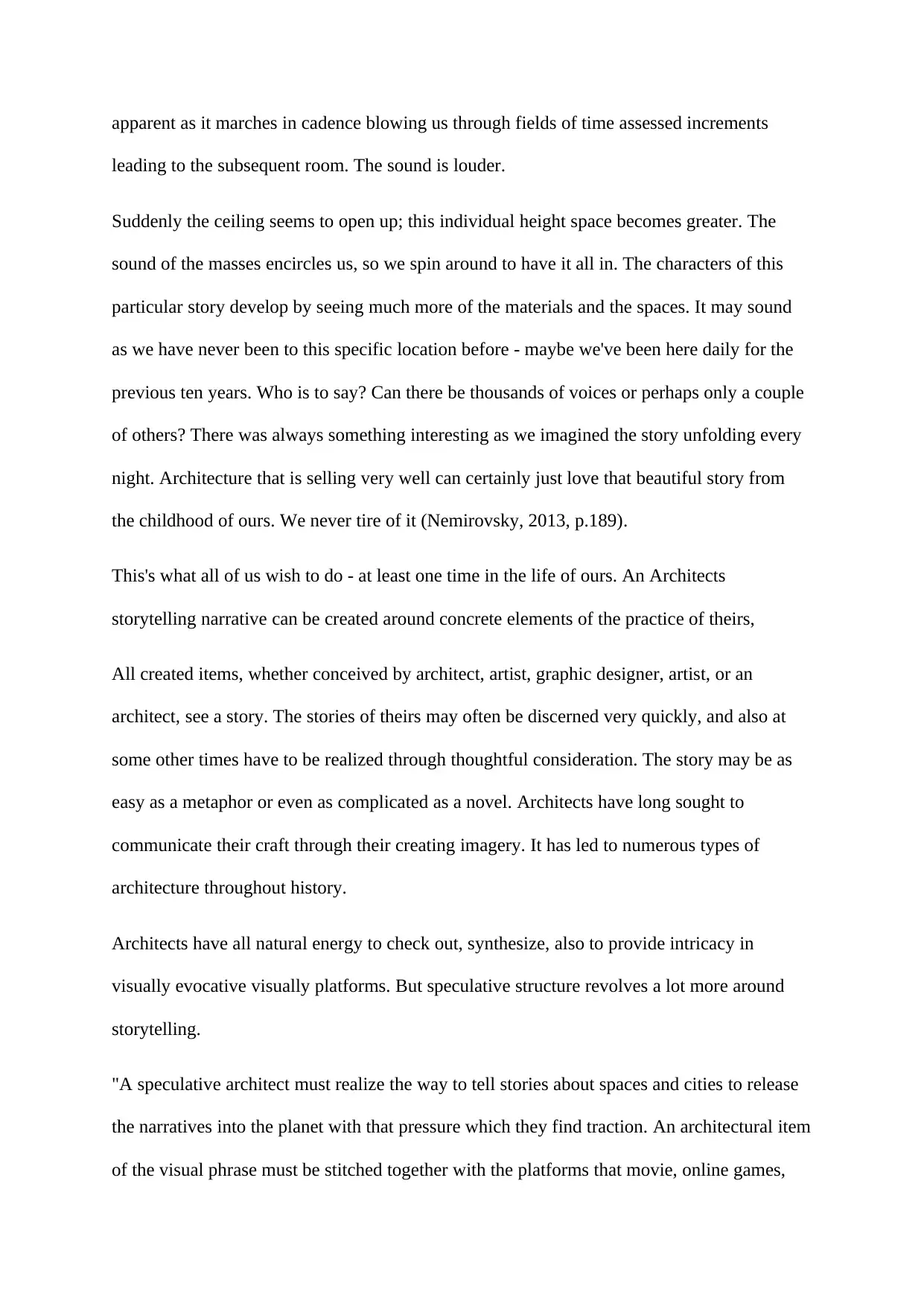
leading to the subsequent room. The sound is louder.
Suddenly the ceiling seems to open up; this individual height space becomes greater. The
sound of the masses encircles us, so we spin around to have it all in. The characters of this
particular story develop by seeing much more of the materials and the spaces. It may sound
as we have never been to this specific location before - maybe we've been here daily for the
previous ten years. Who is to say? Can there be thousands of voices or perhaps only a couple
of others? There was always something interesting as we imagined the story unfolding every
night. Architecture that is selling very well can certainly just love that beautiful story from
the childhood of ours. We never tire of it (Nemirovsky, 2013, p.189).
This's what all of us wish to do - at least one time in the life of ours. An Architects
storytelling narrative can be created around concrete elements of the practice of theirs,
All created items, whether conceived by architect, artist, graphic designer, artist, or an
architect, see a story. The stories of theirs may often be discerned very quickly, and also at
some other times have to be realized through thoughtful consideration. The story may be as
easy as a metaphor or even as complicated as a novel. Architects have long sought to
communicate their craft through their creating imagery. It has led to numerous types of
architecture throughout history.
Architects have all natural energy to check out, synthesize, also to provide intricacy in
visually evocative visually platforms. But speculative structure revolves a lot more around
storytelling.
"A speculative architect must realize the way to tell stories about spaces and cities to release
the narratives into the planet with that pressure which they find traction. An architectural item
of the visual phrase must be stitched together with the platforms that movie, online games,
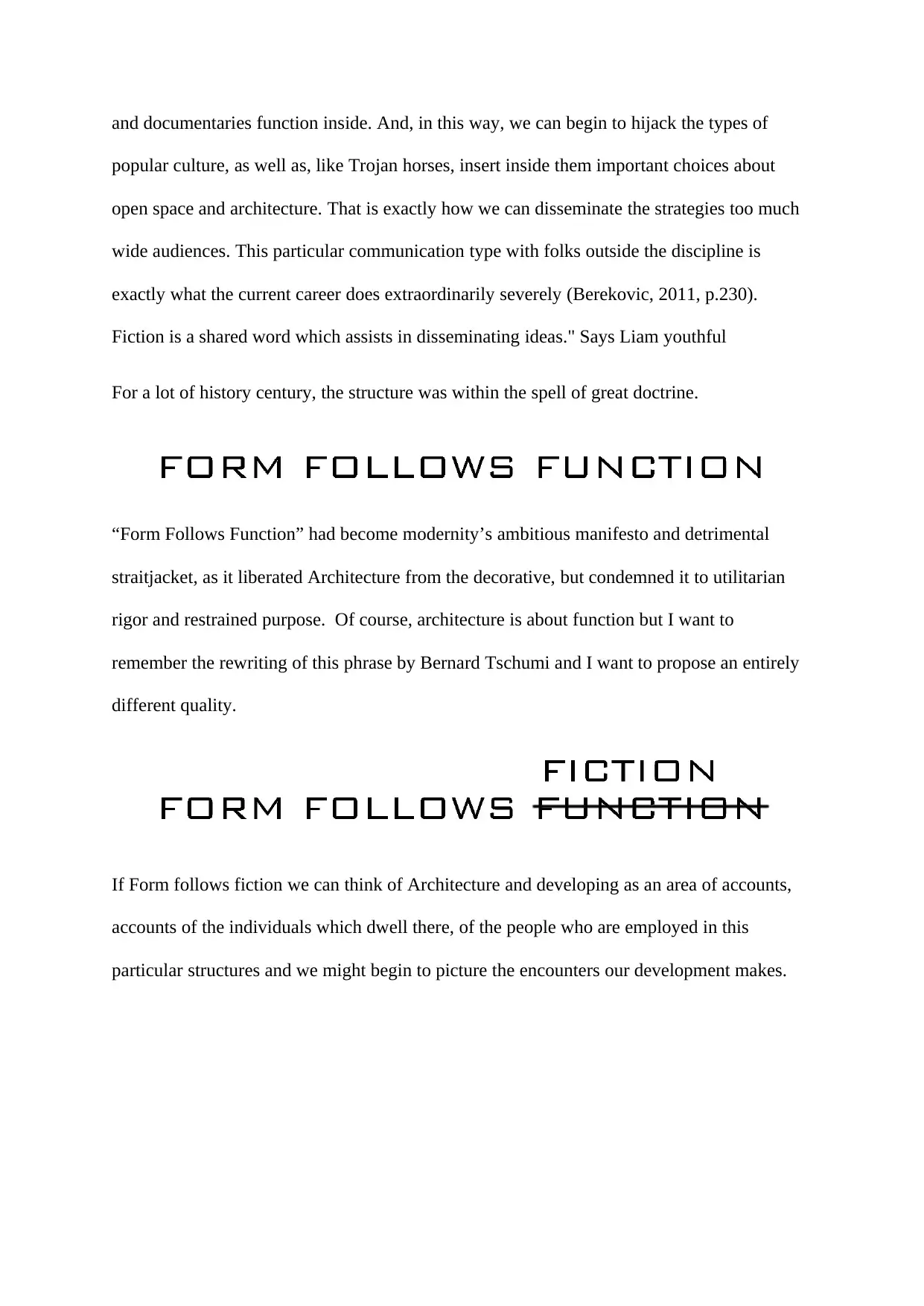
popular culture, as well as, like Trojan horses, insert inside them important choices about
open space and architecture. That is exactly how we can disseminate the strategies too much
wide audiences. This particular communication type with folks outside the discipline is
exactly what the current career does extraordinarily severely (Berekovic, 2011, p.230).
Fiction is a shared word which assists in disseminating ideas." Says Liam youthful
For a lot of history century, the structure was within the spell of great doctrine.
“Form Follows Function” had become modernity’s ambitious manifesto and detrimental
straitjacket, as it liberated Architecture from the decorative, but condemned it to utilitarian
rigor and restrained purpose. Of course, architecture is about function but I want to
remember the rewriting of this phrase by Bernard Tschumi and I want to propose an entirely
different quality.
If Form follows fiction we can think of Architecture and developing as an area of accounts,
accounts of the individuals which dwell there, of the people who are employed in this
particular structures and we might begin to picture the encounters our development makes.
⊘ This is a preview!⊘
Do you want full access?
Subscribe today to unlock all pages.

Trusted by 1+ million students worldwide
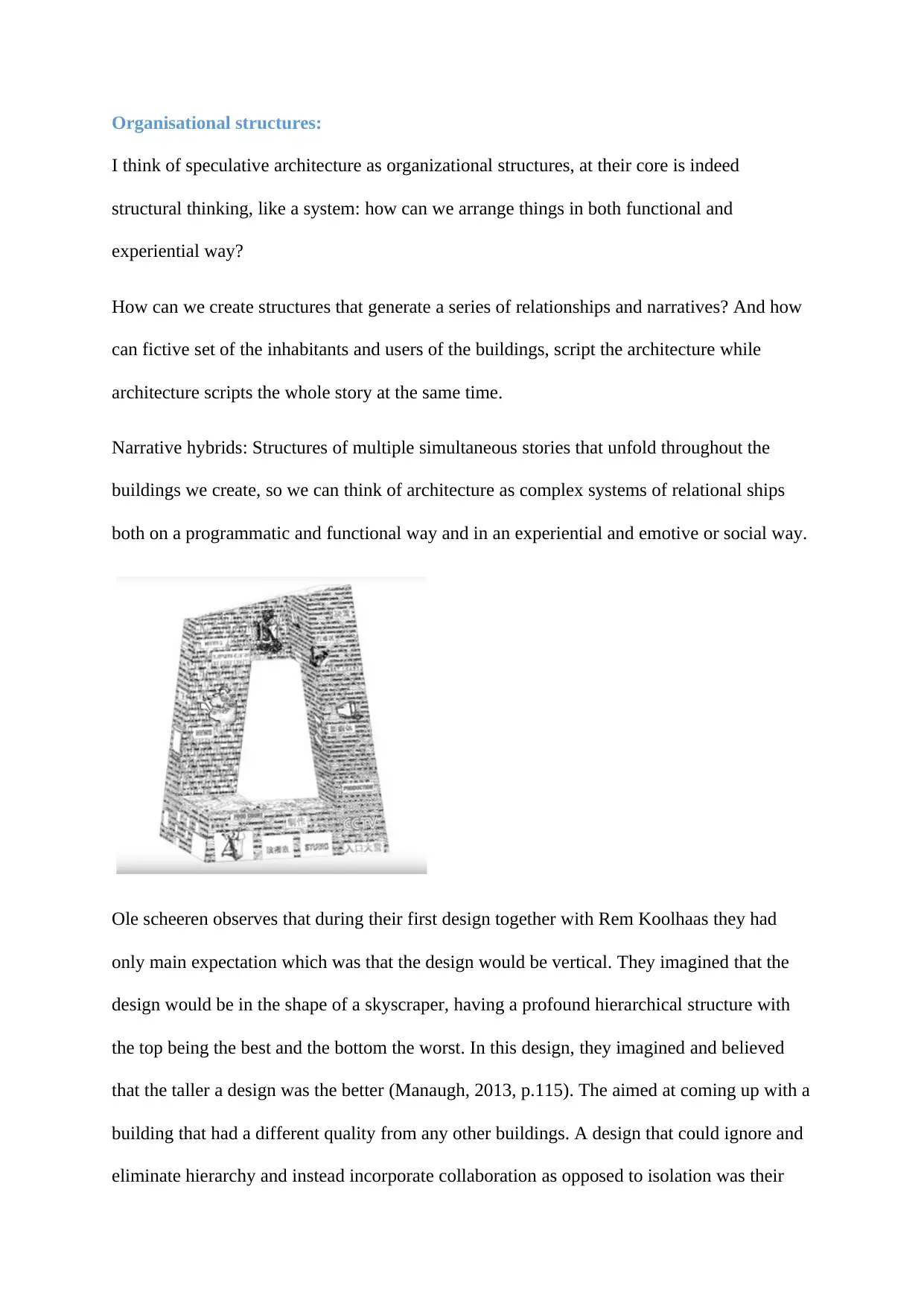
I think of speculative architecture as organizational structures, at their core is indeed
structural thinking, like a system: how can we arrange things in both functional and
experiential way?
How can we create structures that generate a series of relationships and narratives? And how
can fictive set of the inhabitants and users of the buildings, script the architecture while
architecture scripts the whole story at the same time.
Narrative hybrids: Structures of multiple simultaneous stories that unfold throughout the
buildings we create, so we can think of architecture as complex systems of relational ships
both on a programmatic and functional way and in an experiential and emotive or social way.
Ole scheeren observes that during their first design together with Rem Koolhaas they had
only main expectation which was that the design would be vertical. They imagined that the
design would be in the shape of a skyscraper, having a profound hierarchical structure with
the top being the best and the bottom the worst. In this design, they imagined and believed
that the taller a design was the better (Manaugh, 2013, p.115). The aimed at coming up with a
building that had a different quality from any other buildings. A design that could ignore and
eliminate hierarchy and instead incorporate collaboration as opposed to isolation was their
Paraphrase This Document
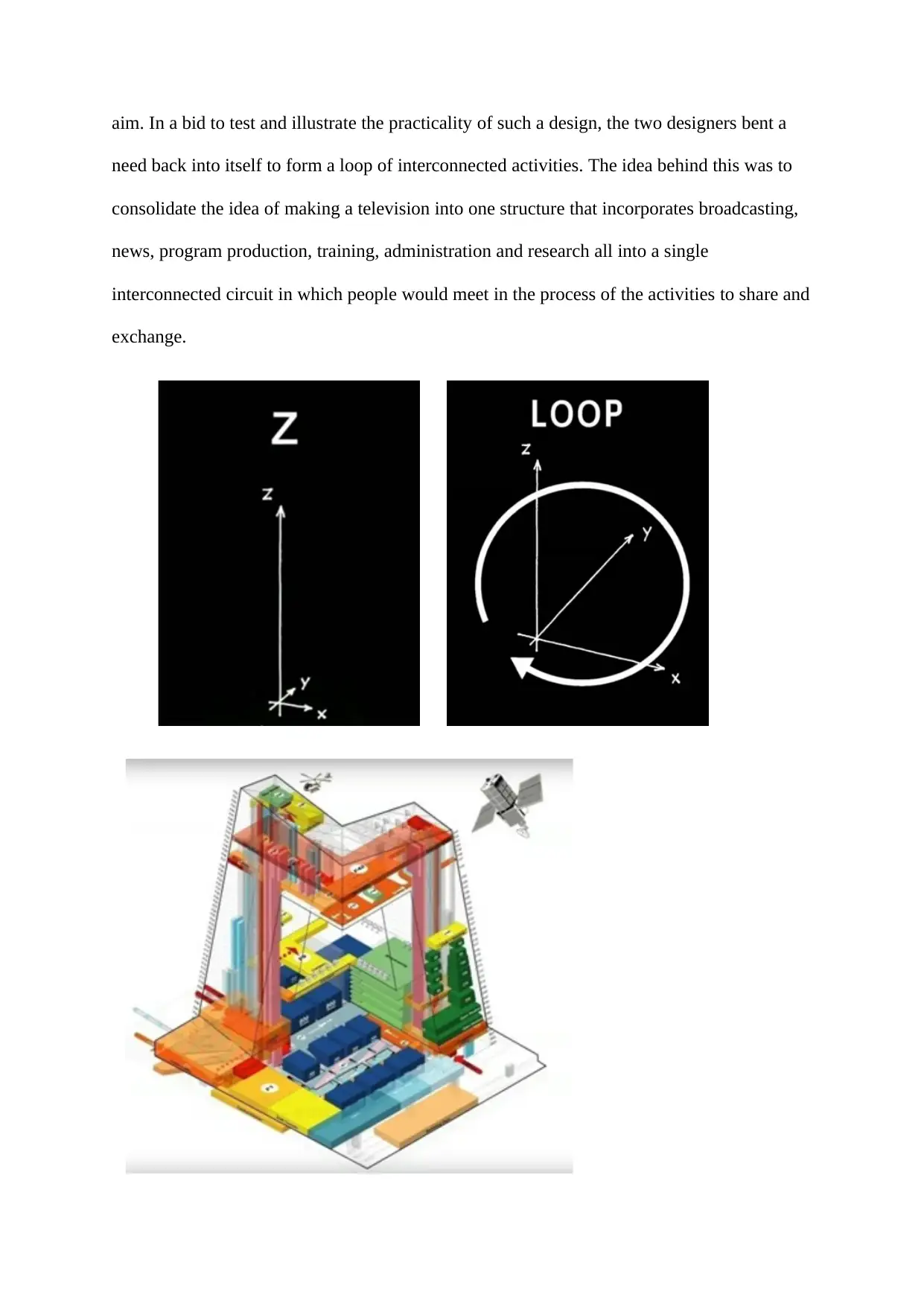
need back into itself to form a loop of interconnected activities. The idea behind this was to
consolidate the idea of making a television into one structure that incorporates broadcasting,
news, program production, training, administration and research all into a single
interconnected circuit in which people would meet in the process of the activities to share and
exchange.

body with all the organs of it’s as well as blood circulation system, such as from school. And
suddenly you believe structure, no more significant the time as a made compound, but as an
organism, as being a life type.
And while you begin to dissect the organism you can determine a sequence of primary
specialized clusters - system generation, broadcasting news, and center. Those're firmly
intertwined with interpersonal clusters: conference areas, canteens chatting areas, casual
spaces for individuals to supply as well as swap. Thus the organizational framework of this
particular construction was a hybrid car between the specialized as well as the cultural, the
man and the performative (Nemirovsky, 2013, p.217). And also naturally, we used the loop
of the structure as a blood circulation phone system to thread everything together as well as to
enable both site visitors as well as staff members to feel all of these various features in a great
unity."
⊘ This is a preview!⊘
Do you want full access?
Subscribe today to unlock all pages.

Trusted by 1+ million students worldwide

backdrop of the city.
It's likewise turned into an extremely popular backdrop for the wedding day photography.
Paraphrase This Document
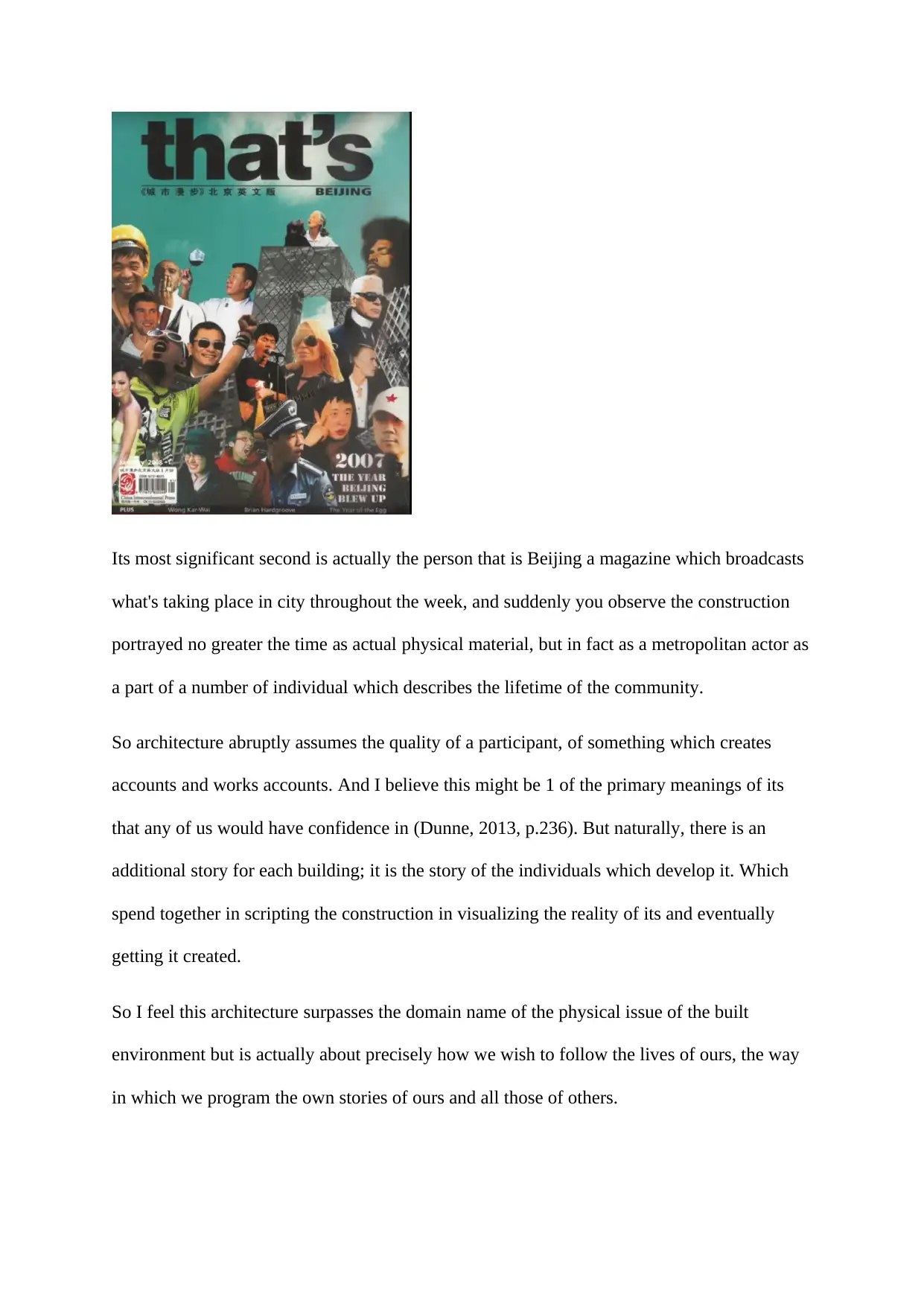
what's taking place in city throughout the week, and suddenly you observe the construction
portrayed no greater the time as actual physical material, but in fact as a metropolitan actor as
a part of a number of individual which describes the lifetime of the community.
So architecture abruptly assumes the quality of a participant, of something which creates
accounts and works accounts. And I believe this might be 1 of the primary meanings of its
that any of us would have confidence in (Dunne, 2013, p.236). But naturally, there is an
additional story for each building; it is the story of the individuals which develop it. Which
spend together in scripting the construction in visualizing the reality of its and eventually
getting it created.
So I feel this architecture surpasses the domain name of the physical issue of the built
environment but is actually about precisely how we wish to follow the lives of ours, the way
in which we program the own stories of ours and all those of others.
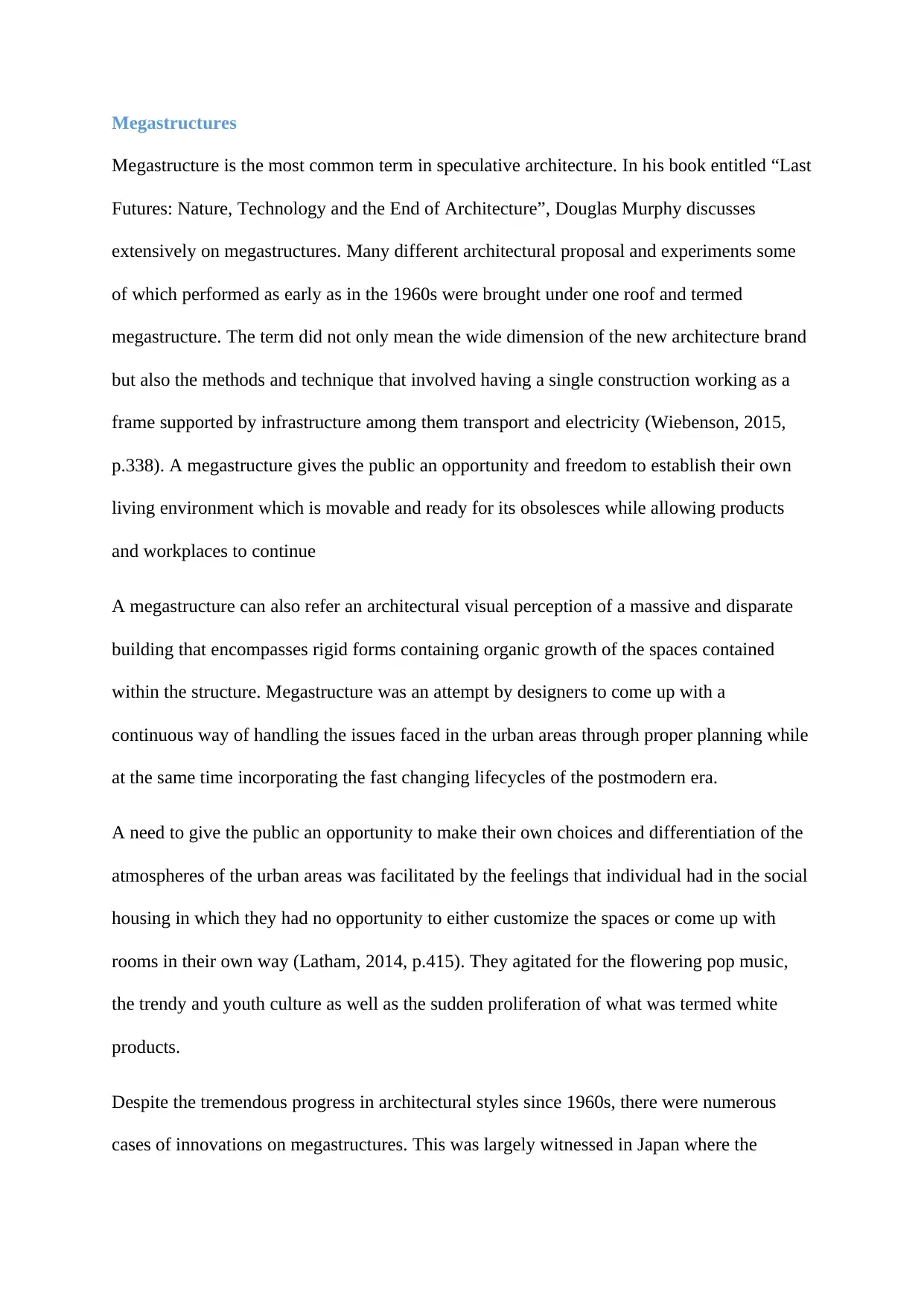
Megastructure is the most common term in speculative architecture. In his book entitled “Last
Futures: Nature, Technology and the End of Architecture”, Douglas Murphy discusses
extensively on megastructures. Many different architectural proposal and experiments some
of which performed as early as in the 1960s were brought under one roof and termed
megastructure. The term did not only mean the wide dimension of the new architecture brand
but also the methods and technique that involved having a single construction working as a
frame supported by infrastructure among them transport and electricity (Wiebenson, 2015,
p.338). A megastructure gives the public an opportunity and freedom to establish their own
living environment which is movable and ready for its obsolesces while allowing products
and workplaces to continue
A megastructure can also refer an architectural visual perception of a massive and disparate
building that encompasses rigid forms containing organic growth of the spaces contained
within the structure. Megastructure was an attempt by designers to come up with a
continuous way of handling the issues faced in the urban areas through proper planning while
at the same time incorporating the fast changing lifecycles of the postmodern era.
A need to give the public an opportunity to make their own choices and differentiation of the
atmospheres of the urban areas was facilitated by the feelings that individual had in the social
housing in which they had no opportunity to either customize the spaces or come up with
rooms in their own way (Latham, 2014, p.415). They agitated for the flowering pop music,
the trendy and youth culture as well as the sudden proliferation of what was termed white
products.
Despite the tremendous progress in architectural styles since 1960s, there were numerous
cases of innovations on megastructures. This was largely witnessed in Japan where the
⊘ This is a preview!⊘
Do you want full access?
Subscribe today to unlock all pages.

Trusted by 1+ million students worldwide

functionality which was a creation of megastructural thinking. Whereas there are a selection
of a number of concrete structures that were built in the 1960s which were representative of
samples of aesthetic megastructures, these were just meant for suggestive ephemerality.
One instance was the Shinjuku bus body developing by Yoji Watanabe of 1970. Watanabe
was a Japanese architect a generation more mature compared to the Metabolists, whose
apartment block accomplishes a seeming capsule as arrangement through the usage of a
notched facade in that any room seems to be separate from the following. This particular
idiosyncratic design looked pretty much like a set of aluminum Airstream caravans had been
trapped onto the central funnel of a battleship, as well as developed an only small fascination
with the architectural media outside of Japan (Lowry, 2017, p.126). Following a variety of
many years of being still left to rot, nonetheless, it's just recently been refurbished and will
continue to exist as an apartment block.
Nakagin Capsule Tower, Kisho Kurokawa
Paraphrase This Document
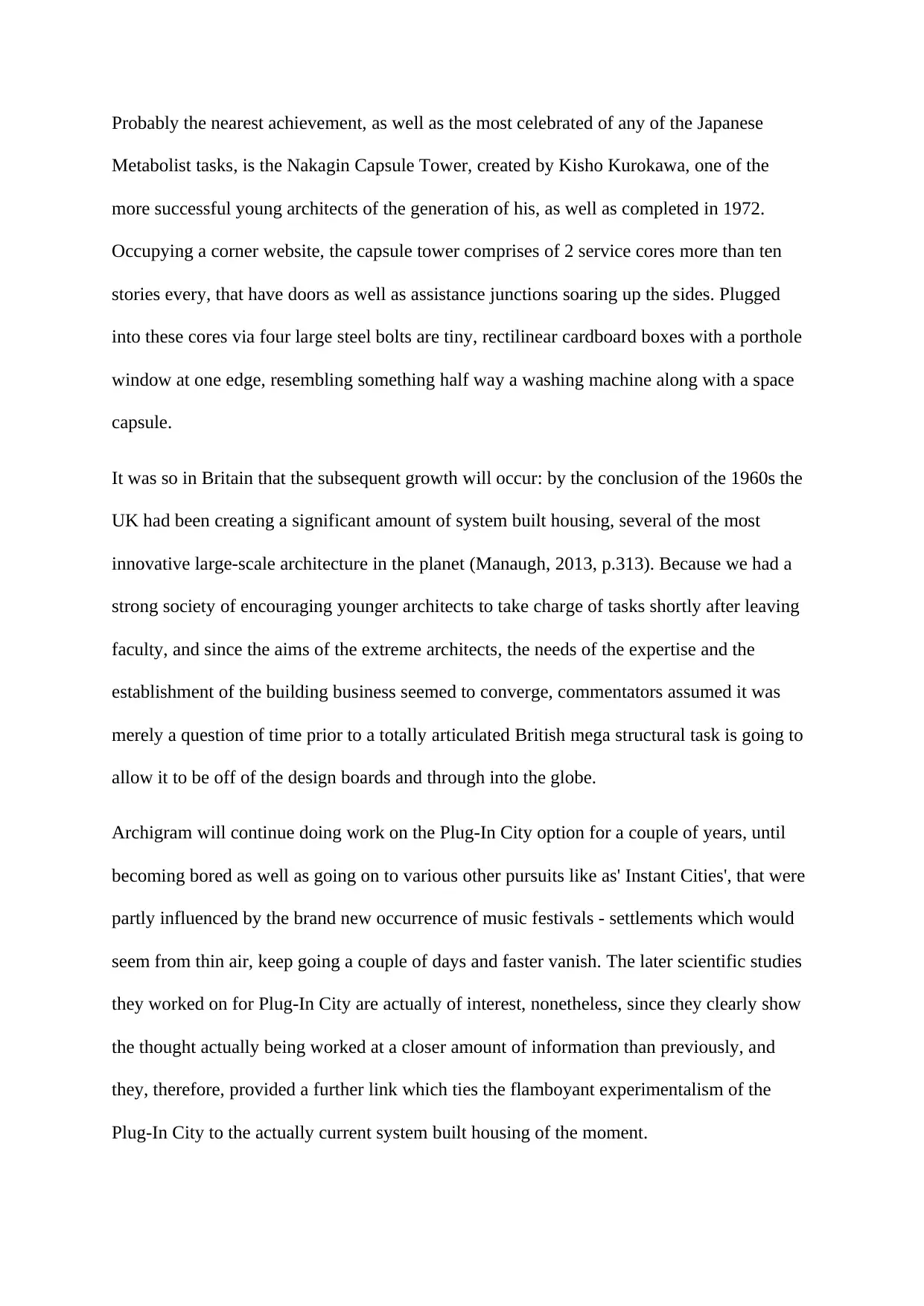
Metabolist tasks, is the Nakagin Capsule Tower, created by Kisho Kurokawa, one of the
more successful young architects of the generation of his, as well as completed in 1972.
Occupying a corner website, the capsule tower comprises of 2 service cores more than ten
stories every, that have doors as well as assistance junctions soaring up the sides. Plugged
into these cores via four large steel bolts are tiny, rectilinear cardboard boxes with a porthole
window at one edge, resembling something half way a washing machine along with a space
capsule.
It was so in Britain that the subsequent growth will occur: by the conclusion of the 1960s the
UK had been creating a significant amount of system built housing, several of the most
innovative large-scale architecture in the planet (Manaugh, 2013, p.313). Because we had a
strong society of encouraging younger architects to take charge of tasks shortly after leaving
faculty, and since the aims of the extreme architects, the needs of the expertise and the
establishment of the building business seemed to converge, commentators assumed it was
merely a question of time prior to a totally articulated British mega structural task is going to
allow it to be off of the design boards and through into the globe.
Archigram will continue doing work on the Plug-In City option for a couple of years, until
becoming bored as well as going on to various other pursuits like as' Instant Cities', that were
partly influenced by the brand new occurrence of music festivals - settlements which would
seem from thin air, keep going a couple of days and faster vanish. The later scientific studies
they worked on for Plug-In City are actually of interest, nonetheless, since they clearly show
the thought actually being worked at a closer amount of information than previously, and
they, therefore, provided a further link which ties the flamboyant experimentalism of the
Plug-In City to the actually current system built housing of the moment.
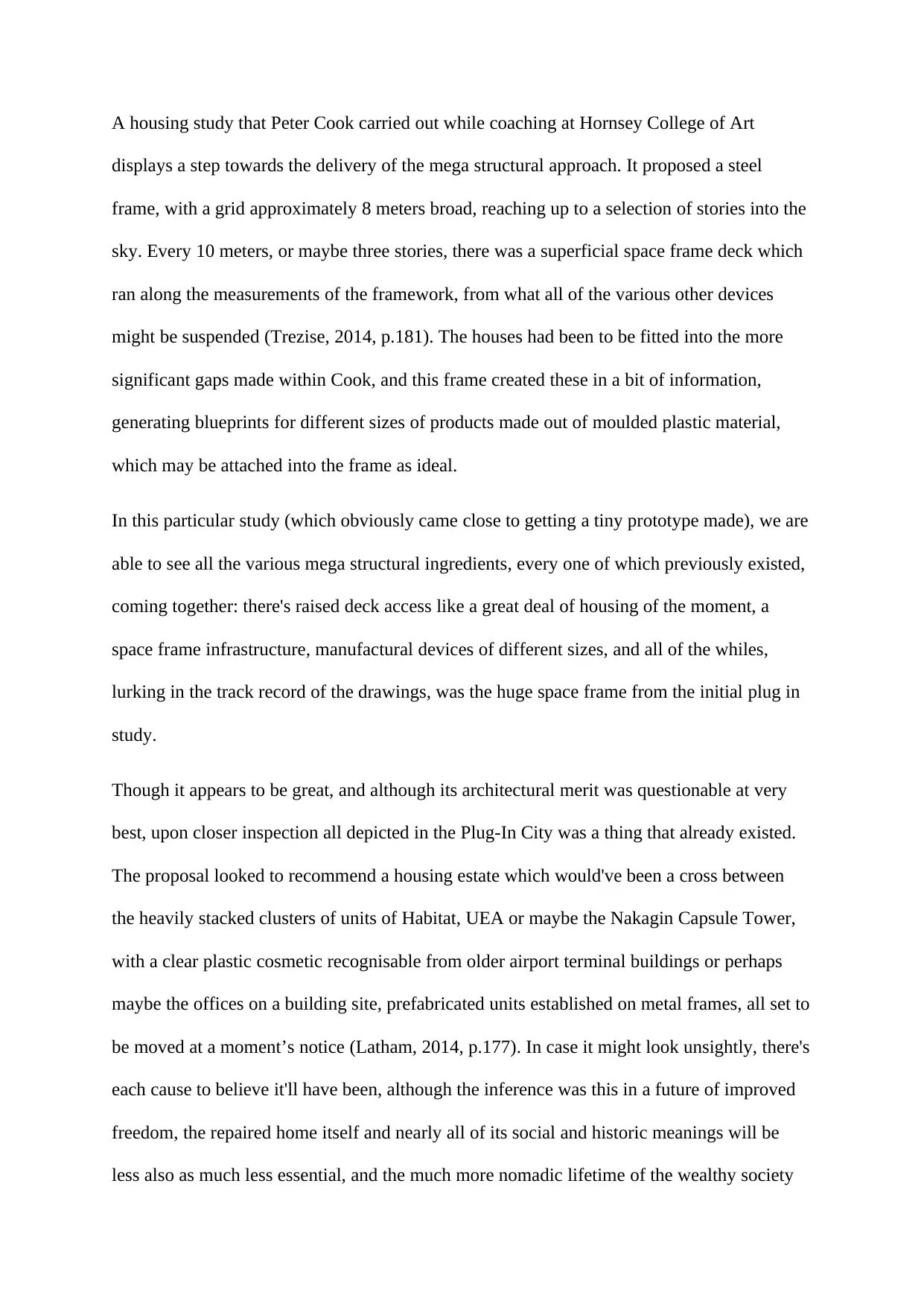
displays a step towards the delivery of the mega structural approach. It proposed a steel
frame, with a grid approximately 8 meters broad, reaching up to a selection of stories into the
sky. Every 10 meters, or maybe three stories, there was a superficial space frame deck which
ran along the measurements of the framework, from what all of the various other devices
might be suspended (Trezise, 2014, p.181). The houses had been to be fitted into the more
significant gaps made within Cook, and this frame created these in a bit of information,
generating blueprints for different sizes of products made out of moulded plastic material,
which may be attached into the frame as ideal.
In this particular study (which obviously came close to getting a tiny prototype made), we are
able to see all the various mega structural ingredients, every one of which previously existed,
coming together: there's raised deck access like a great deal of housing of the moment, a
space frame infrastructure, manufactural devices of different sizes, and all of the whiles,
lurking in the track record of the drawings, was the huge space frame from the initial plug in
study.
Though it appears to be great, and although its architectural merit was questionable at very
best, upon closer inspection all depicted in the Plug-In City was a thing that already existed.
The proposal looked to recommend a housing estate which would've been a cross between
the heavily stacked clusters of units of Habitat, UEA or maybe the Nakagin Capsule Tower,
with a clear plastic cosmetic recognisable from older airport terminal buildings or perhaps
maybe the offices on a building site, prefabricated units established on metal frames, all set to
be moved at a moment’s notice (Latham, 2014, p.177). In case it might look unsightly, there's
each cause to believe it'll have been, although the inference was this in a future of improved
freedom, the repaired home itself and nearly all of its social and historic meanings will be
less also as much less essential, and the much more nomadic lifetime of the wealthy society
⊘ This is a preview!⊘
Do you want full access?
Subscribe today to unlock all pages.

Trusted by 1+ million students worldwide
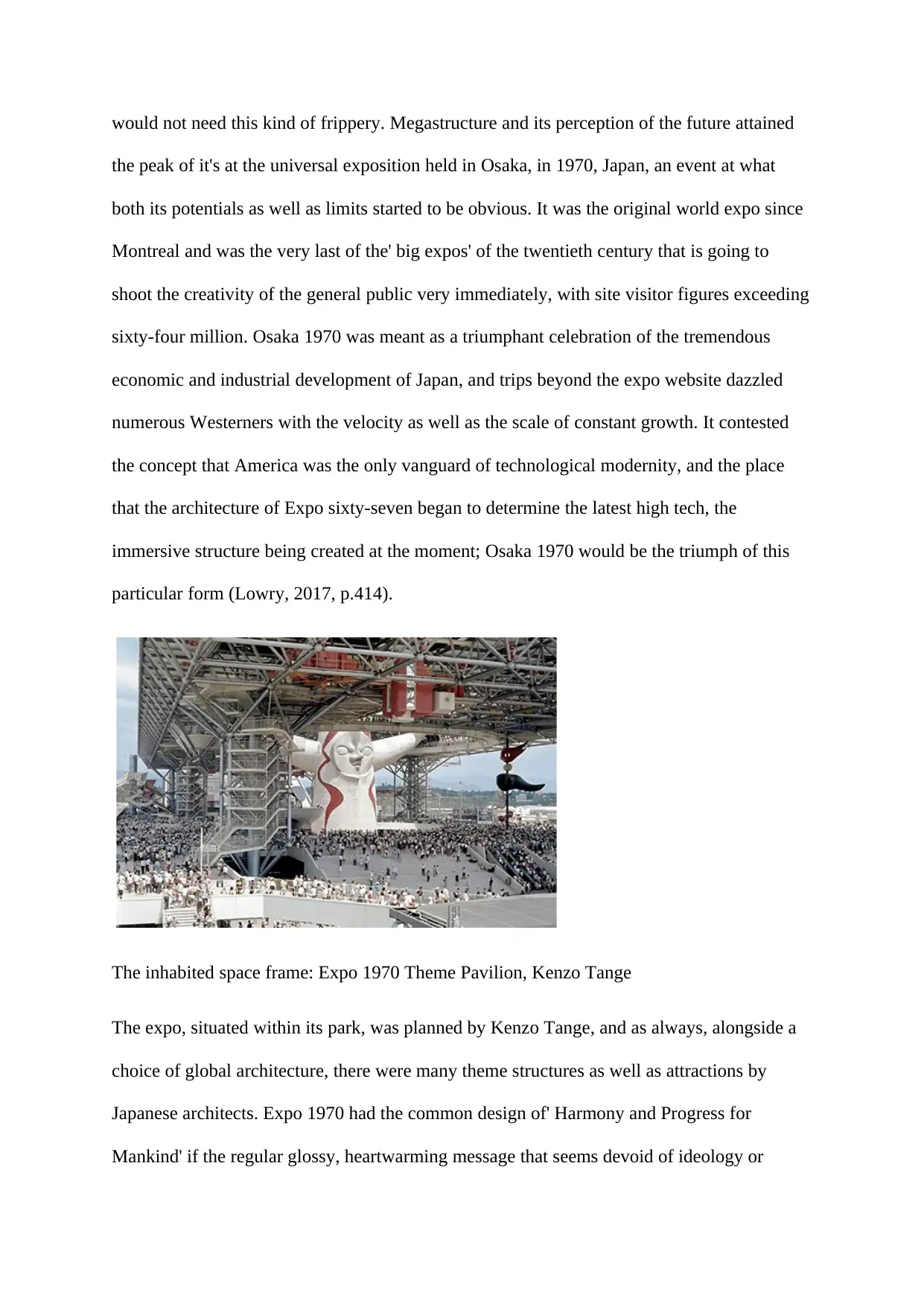
the peak of it's at the universal exposition held in Osaka, in 1970, Japan, an event at what
both its potentials as well as limits started to be obvious. It was the original world expo since
Montreal and was the very last of the' big expos' of the twentieth century that is going to
shoot the creativity of the general public very immediately, with site visitor figures exceeding
sixty-four million. Osaka 1970 was meant as a triumphant celebration of the tremendous
economic and industrial development of Japan, and trips beyond the expo website dazzled
numerous Westerners with the velocity as well as the scale of constant growth. It contested
the concept that America was the only vanguard of technological modernity, and the place
that the architecture of Expo sixty-seven began to determine the latest high tech, the
immersive structure being created at the moment; Osaka 1970 would be the triumph of this
particular form (Lowry, 2017, p.414).
The inhabited space frame: Expo 1970 Theme Pavilion, Kenzo Tange
The expo, situated within its park, was planned by Kenzo Tange, and as always, alongside a
choice of global architecture, there were many theme structures as well as attractions by
Japanese architects. Expo 1970 had the common design of' Harmony and Progress for
Mankind' if the regular glossy, heartwarming message that seems devoid of ideology or
Paraphrase This Document
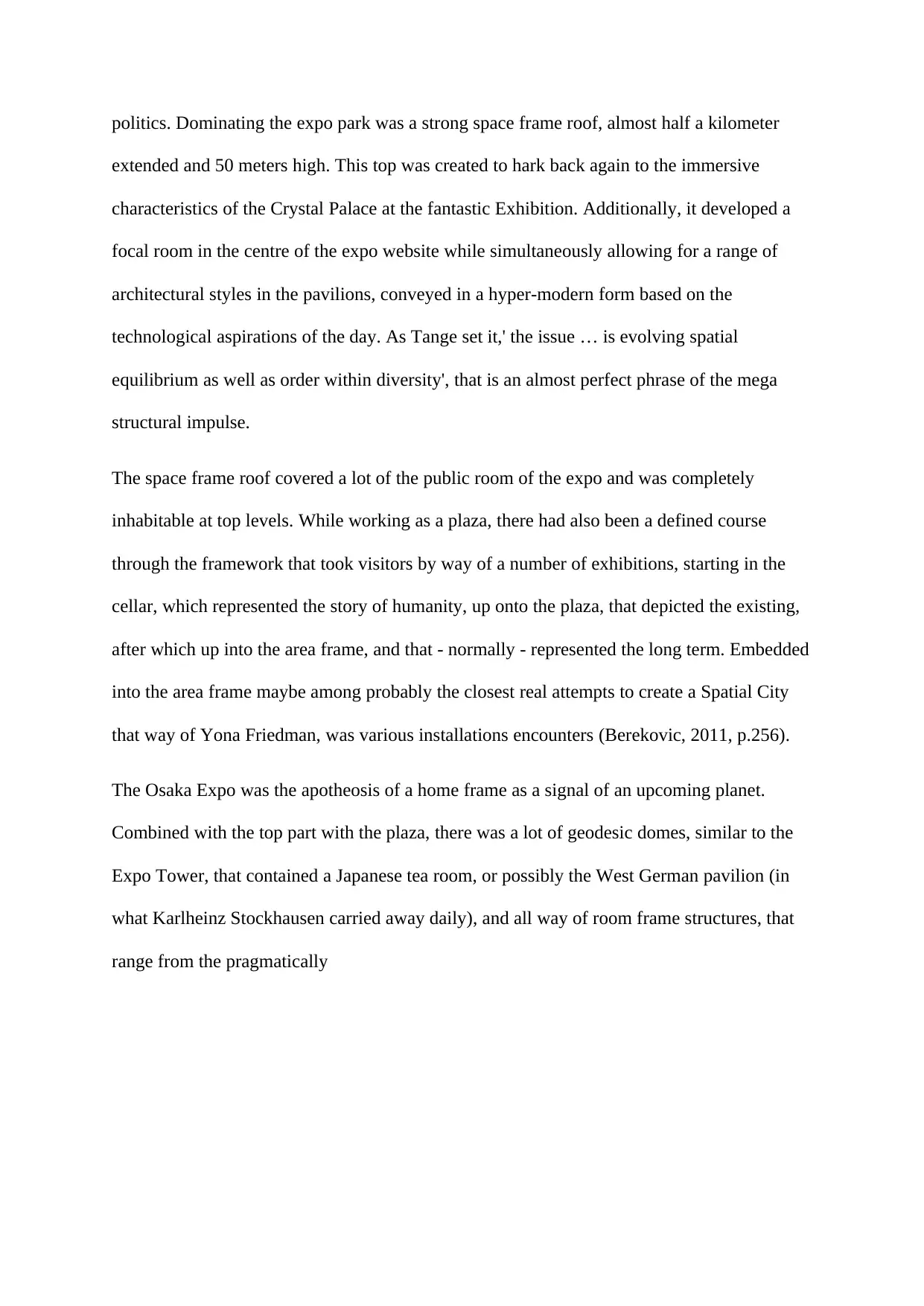
extended and 50 meters high. This top was created to hark back again to the immersive
characteristics of the Crystal Palace at the fantastic Exhibition. Additionally, it developed a
focal room in the centre of the expo website while simultaneously allowing for a range of
architectural styles in the pavilions, conveyed in a hyper-modern form based on the
technological aspirations of the day. As Tange set it,' the issue … is evolving spatial
equilibrium as well as order within diversity', that is an almost perfect phrase of the mega
structural impulse.
The space frame roof covered a lot of the public room of the expo and was completely
inhabitable at top levels. While working as a plaza, there had also been a defined course
through the framework that took visitors by way of a number of exhibitions, starting in the
cellar, which represented the story of humanity, up onto the plaza, that depicted the existing,
after which up into the area frame, and that - normally - represented the long term. Embedded
into the area frame maybe among probably the closest real attempts to create a Spatial City
that way of Yona Friedman, was various installations encounters (Berekovic, 2011, p.256).
The Osaka Expo was the apotheosis of a home frame as a signal of an upcoming planet.
Combined with the top part with the plaza, there was a lot of geodesic domes, similar to the
Expo Tower, that contained a Japanese tea room, or possibly the West German pavilion (in
what Karlheinz Stockhausen carried away daily), and all way of room frame structures, that
range from the pragmatically

Far too often, megastructure proposals nowadays seem to be far too much like fantasy, like
something from the cover of a low 1970s sci-fi novel. Huge tents over cities, cities built out
over the ocean, underwater cities, room cities - typically these seem to us today love trite
fantasy (Latham, 2014, p.451). The rise of' Google Earth urbanism,' like the great island
reclamations of Dubai from the very first ten years of the twenty-first century, carried
absolutely nothing of the promise of completely new means of living that these earlier
schemes did. In a particular way, we were able to think of this as the curse of the expo, the
instilled assumption, based mostly upon a combination of propaganda and experience, that
fast technological progress was changing everything, permanently. Though it's worth looking
more into exactly how these suggestions disseminated into the mainstream of developing, as
they predictably did. Probably the most obvious unique case, and one which Banham picked
up on when the previous term in megastructure, was the Centre Pompidou in Paris, created by
Richard Rogers and Renzo Piano and finished in 1977 (Dunne, 2013, p.258).Usually seen as
the last hurrah of Archigram's' Zoom' pattern of indeterminate, flexible and replaceable
architecture, it's both a really effective public room in addition to a monument to the
malfunction of that new notion of the community to take proper root, don't attaining really a
⊘ This is a preview!⊘
Do you want full access?
Subscribe today to unlock all pages.

Trusted by 1+ million students worldwide
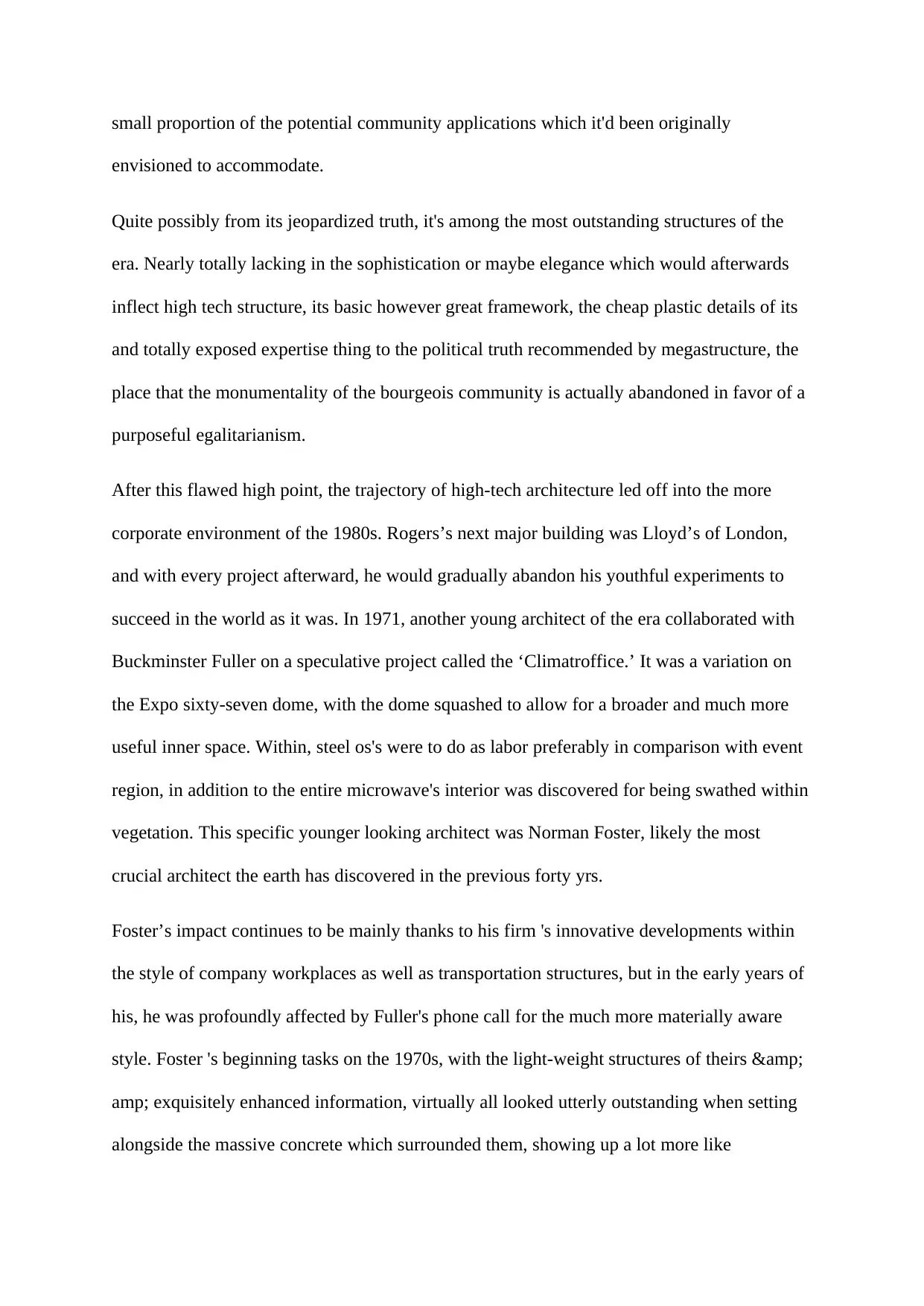
envisioned to accommodate.
Quite possibly from its jeopardized truth, it's among the most outstanding structures of the
era. Nearly totally lacking in the sophistication or maybe elegance which would afterwards
inflect high tech structure, its basic however great framework, the cheap plastic details of its
and totally exposed expertise thing to the political truth recommended by megastructure, the
place that the monumentality of the bourgeois community is actually abandoned in favor of a
purposeful egalitarianism.
After this flawed high point, the trajectory of high-tech architecture led off into the more
corporate environment of the 1980s. Rogers’s next major building was Lloyd’s of London,
and with every project afterward, he would gradually abandon his youthful experiments to
succeed in the world as it was. In 1971, another young architect of the era collaborated with
Buckminster Fuller on a speculative project called the ‘Climatroffice.’ It was a variation on
the Expo sixty-seven dome, with the dome squashed to allow for a broader and much more
useful inner space. Within, steel os's were to do as labor preferably in comparison with event
region, in addition to the entire microwave's interior was discovered for being swathed within
vegetation. This specific younger looking architect was Norman Foster, likely the most
crucial architect the earth has discovered in the previous forty yrs.
Foster’s impact continues to be mainly thanks to his firm 's innovative developments within
the style of company workplaces as well as transportation structures, but in the early years of
his, he was profoundly affected by Fuller's phone call for the much more materially aware
style. Foster 's beginning tasks on the 1970s, with the light-weight structures of theirs &
amp; exquisitely enhanced information, virtually all looked utterly outstanding when setting
alongside the massive concrete which surrounded them, showing up a lot more like
Paraphrase This Document

2012, p.239).
During the 1970s Foster would get an excellent art form facility on the justification of the
Faculty of East Anglia, dealing with Lasdun's complicated of ziggurat casing. This particular
entirely new framework, donated through the Sainsbury grocery store dynasty as being a
vessel to display the fantastic art form group of theirs, would have been a shed and have an
area frame top enclosing a huge adaptable inner space, clad to the outside within featureless
white colored sections. It was a somewhat shocking juxtaposition associated with a
significant society room aided by the neat and featureless architectural know-how linked to
your computer chip factory and this specific working day is a thrillingly strange architectural
encounter - Bacon and Giacometti within an airport terminal living room.
But the creativity of these and other tasks by high tech architects, so obviously indebted to
the prior experiments, wasn't sufficient to prevent their strategies being bit by bit diluted into
the banality of the contemporary workplace block as we realize it today (Wiebenson, 2015,
p.154). A modern office block does satisfy a lot of areas of the megastructural ethos. It's
typically built with probably the blankest plans possible, including an elevated flooring that
contains electric connections along with a suspended ceiling with ventilation and lights. This
particular blank, the polished interior is then usually performed by designers working for the
businesses that are renting the space. In go carpets, desks, partitions and all of the rest,
replaceable and flexible. Within the curtain wall space of an office block, and really in the
robotic arms that operate on rails and hold the window cleaning cradles, a certain flickering
echo of the megastructure fantasy continues to exist.
On a bigger scale, Norman Foster once more pioneered the larger envelope as the dominant
procedure for one more typology, this moment at Stansted Airport, constructed all over the

p.569). Today one can continue to buy a hint of the megastructure ideal when passing
through an airport, because of their huge roof structures, the miles of theirs of constant inner
room, the adaptable shops and security facilities which may be taken down and moved over
time without annoying the exterior, never to point out the connecting arms that rotate as well
as extend towards the aircraft, the ever-so-futuristic monorails as well as the intersecting
transport facilities.
Elsewhere, Martin Pawley's perspective of the room frame at the Osaka Expo in 1970,
probably the blankest of boxes serving an inside of change that is constant and mediated
usage, bit by bit mutated over time into the huge sheds which function as distribution points
for items - huge blank styles attached into transport infrastructure at crucial nodes of exercise
and able to being erected as well as taken down in an extremely short room of time. Pawley
thought that these buildings, widely known as' big sheds,' were' the architecture that can
dominate the twenty-first century,' and it's been claimed that in their massive blankness' they
render architecture redundant.' But in the way of theirs, they're the technologies that Fuller
and Otto along with most of the others had been dreaming of, particularly today in their
roboticised form, because of their enhanced networks of distribution and demand.
If we move even more back in the distribution chain, we come to the container port; these
eerie zones celebrated when the utterly blank spaces of trade, their massive robot cranes
loading and unloading ships in automatic, computerized synchronization (Trezise, 2014,
p.369). It had been in 1968 that the shipping container was standardised, as well as the
consequences are well known: the unexpected rise in dimensions of ship that the container
made probably meant that a lot of the old ports had been rendered useless as well as had to be
transferred to serious water locations just where they might spread out more, giving large
numbers of folks across the world with no jobs. And naturally, what's the shipping container
⊘ This is a preview!⊘
Do you want full access?
Subscribe today to unlock all pages.

Trusted by 1+ million students worldwide
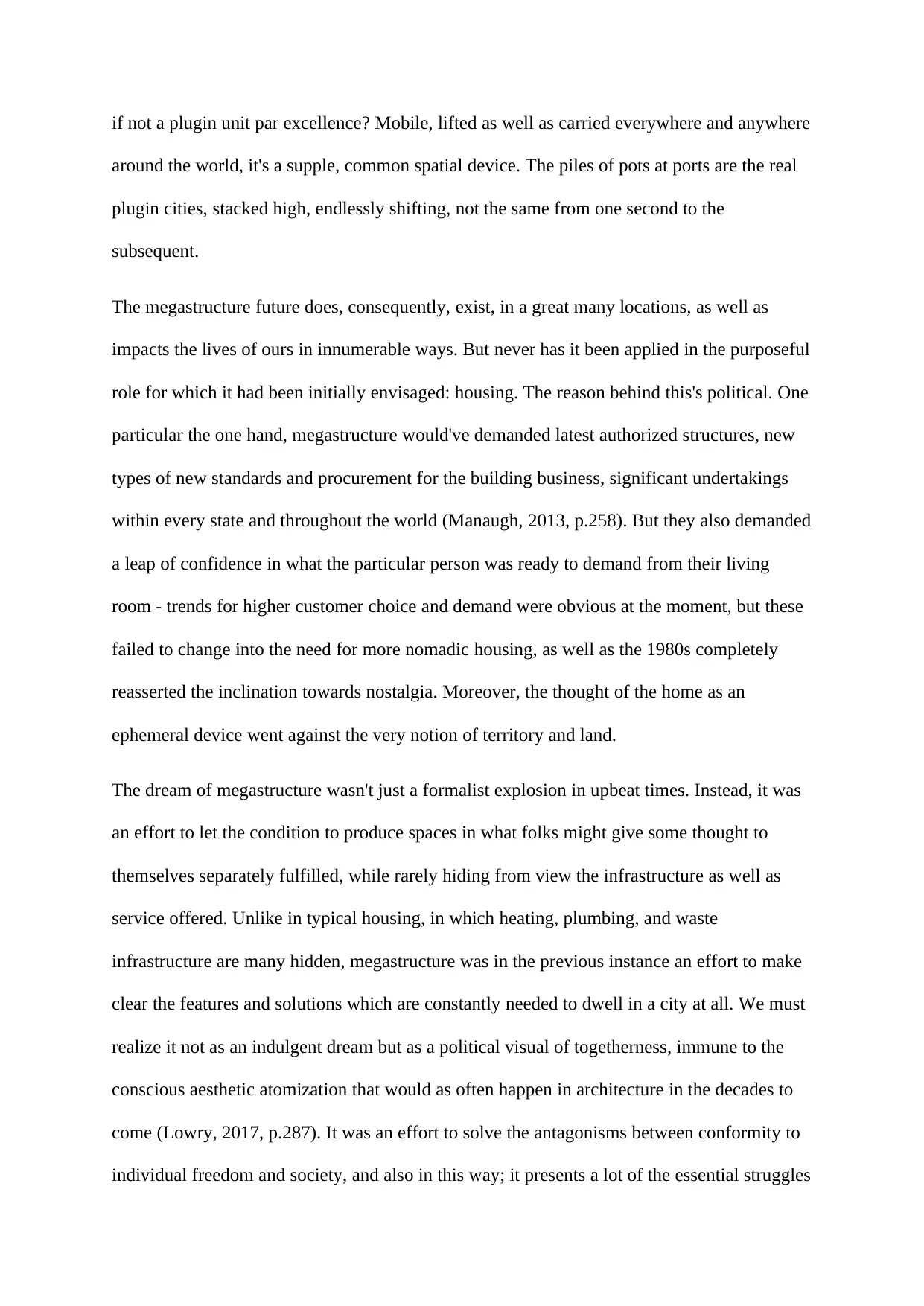
around the world, it's a supple, common spatial device. The piles of pots at ports are the real
plugin cities, stacked high, endlessly shifting, not the same from one second to the
subsequent.
The megastructure future does, consequently, exist, in a great many locations, as well as
impacts the lives of ours in innumerable ways. But never has it been applied in the purposeful
role for which it had been initially envisaged: housing. The reason behind this's political. One
particular the one hand, megastructure would've demanded latest authorized structures, new
types of new standards and procurement for the building business, significant undertakings
within every state and throughout the world (Manaugh, 2013, p.258). But they also demanded
a leap of confidence in what the particular person was ready to demand from their living
room - trends for higher customer choice and demand were obvious at the moment, but these
failed to change into the need for more nomadic housing, as well as the 1980s completely
reasserted the inclination towards nostalgia. Moreover, the thought of the home as an
ephemeral device went against the very notion of territory and land.
The dream of megastructure wasn't just a formalist explosion in upbeat times. Instead, it was
an effort to let the condition to produce spaces in what folks might give some thought to
themselves separately fulfilled, while rarely hiding from view the infrastructure as well as
service offered. Unlike in typical housing, in which heating, plumbing, and waste
infrastructure are many hidden, megastructure was in the previous instance an effort to make
clear the features and solutions which are constantly needed to dwell in a city at all. We must
realize it not as an indulgent dream but as a political visual of togetherness, immune to the
conscious aesthetic atomization that would as often happen in architecture in the decades to
come (Lowry, 2017, p.287). It was an effort to solve the antagonisms between conformity to
individual freedom and society, and also in this way; it presents a lot of the essential struggles
Paraphrase This Document
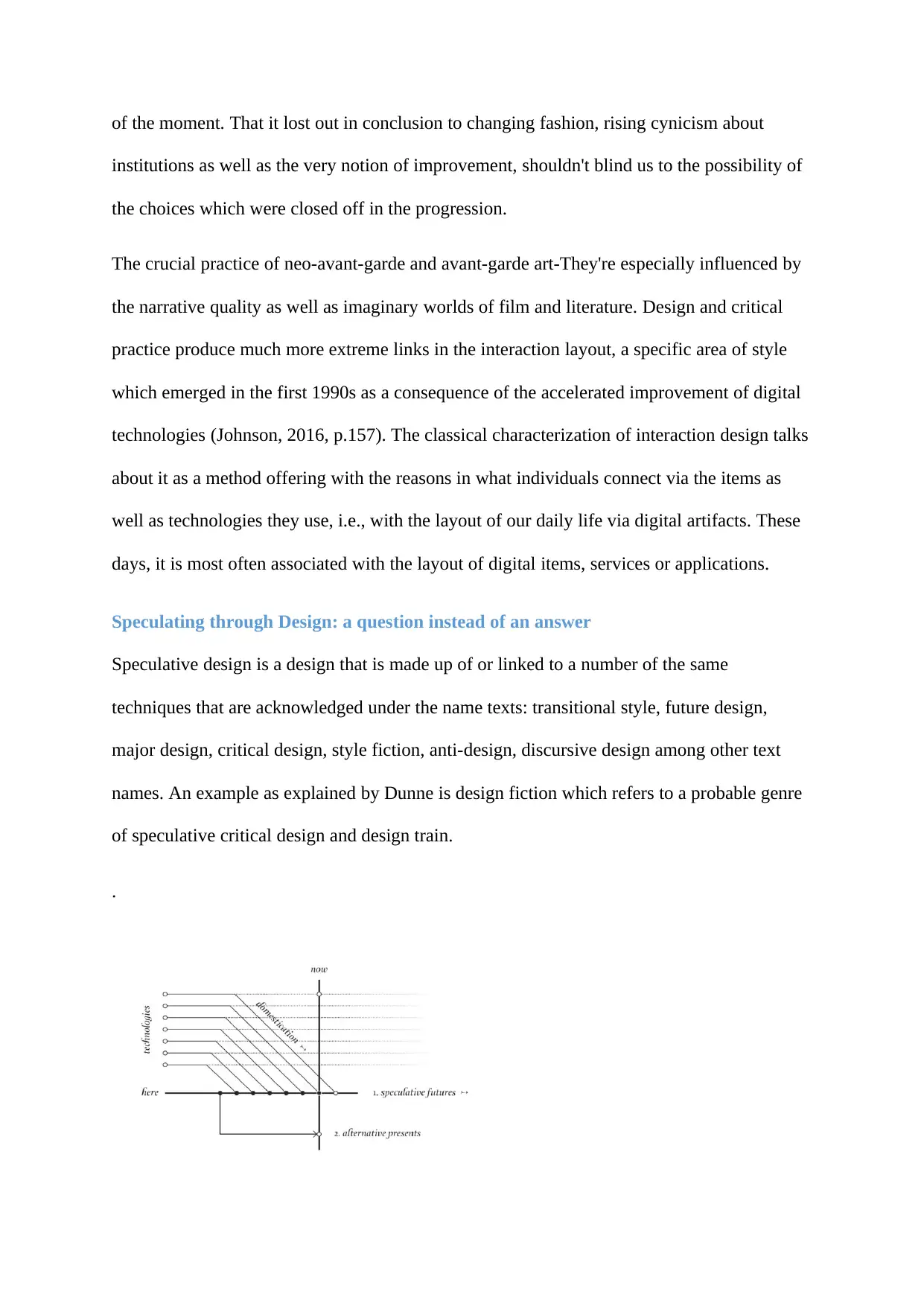
institutions as well as the very notion of improvement, shouldn't blind us to the possibility of
the choices which were closed off in the progression.
The crucial practice of neo-avant-garde and avant-garde art-They're especially influenced by
the narrative quality as well as imaginary worlds of film and literature. Design and critical
practice produce much more extreme links in the interaction layout, a specific area of style
which emerged in the first 1990s as a consequence of the accelerated improvement of digital
technologies (Johnson, 2016, p.157). The classical characterization of interaction design talks
about it as a method offering with the reasons in what individuals connect via the items as
well as technologies they use, i.e., with the layout of our daily life via digital artifacts. These
days, it is most often associated with the layout of digital items, services or applications.
Speculating through Design: a question instead of an answer
Speculative design is a design that is made up of or linked to a number of the same
techniques that are acknowledged under the name texts: transitional style, future design,
major design, critical design, style fiction, anti-design, discursive design among other text
names. An example as explained by Dunne is design fiction which refers to a probable genre
of speculative critical design and design train.
.
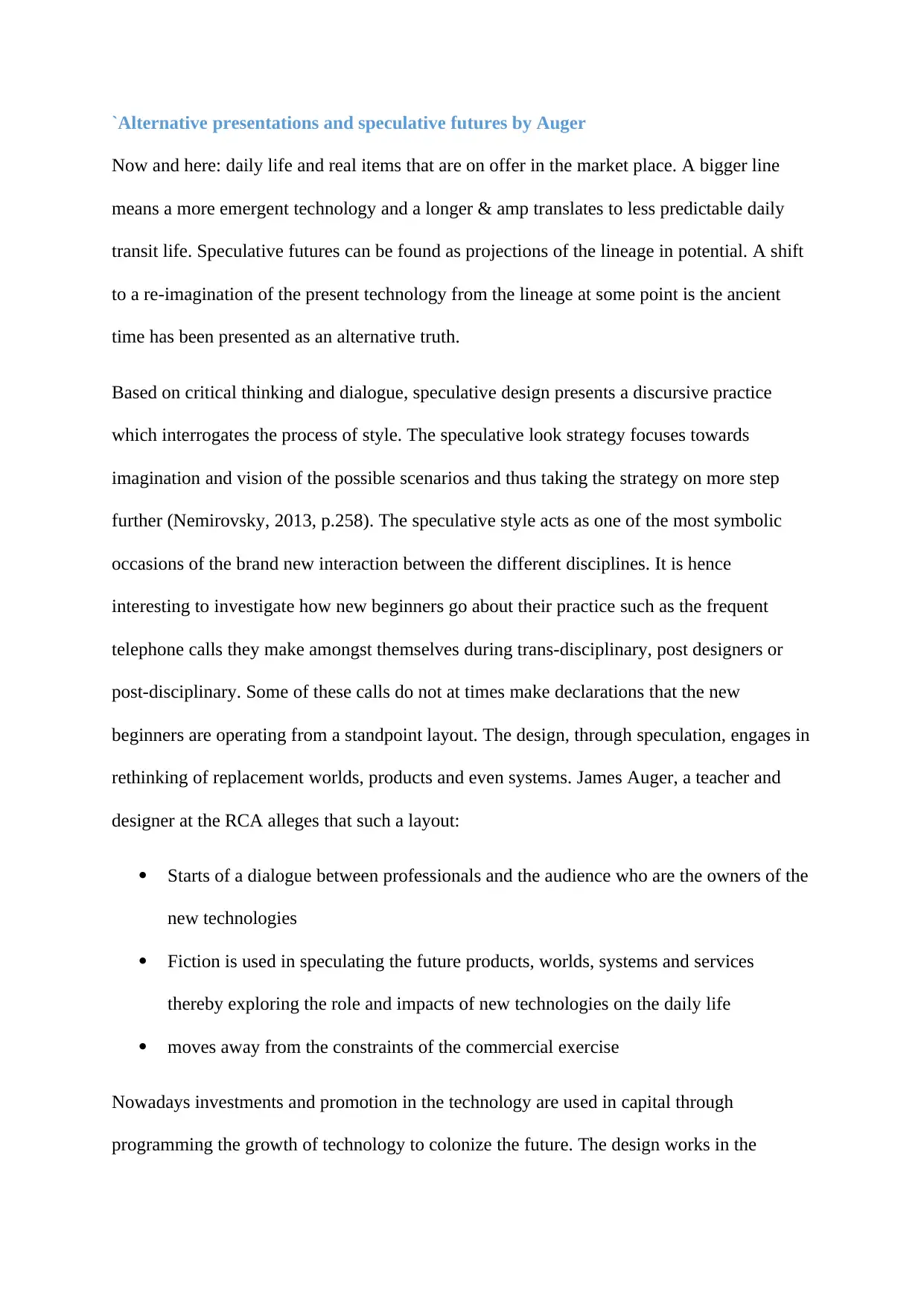
Now and here: daily life and real items that are on offer in the market place. A bigger line
means a more emergent technology and a longer & amp translates to less predictable daily
transit life. Speculative futures can be found as projections of the lineage in potential. A shift
to a re-imagination of the present technology from the lineage at some point is the ancient
time has been presented as an alternative truth.
Based on critical thinking and dialogue, speculative design presents a discursive practice
which interrogates the process of style. The speculative look strategy focuses towards
imagination and vision of the possible scenarios and thus taking the strategy on more step
further (Nemirovsky, 2013, p.258). The speculative style acts as one of the most symbolic
occasions of the brand new interaction between the different disciplines. It is hence
interesting to investigate how new beginners go about their practice such as the frequent
telephone calls they make amongst themselves during trans-disciplinary, post designers or
post-disciplinary. Some of these calls do not at times make declarations that the new
beginners are operating from a standpoint layout. The design, through speculation, engages in
rethinking of replacement worlds, products and even systems. James Auger, a teacher and
designer at the RCA alleges that such a layout:
Starts of a dialogue between professionals and the audience who are the owners of the
new technologies
Fiction is used in speculating the future products, worlds, systems and services
thereby exploring the role and impacts of new technologies on the daily life
moves away from the constraints of the commercial exercise
Nowadays investments and promotion in the technology are used in capital through
programming the growth of technology to colonize the future. The design works in the
⊘ This is a preview!⊘
Do you want full access?
Subscribe today to unlock all pages.

Trusted by 1+ million students worldwide
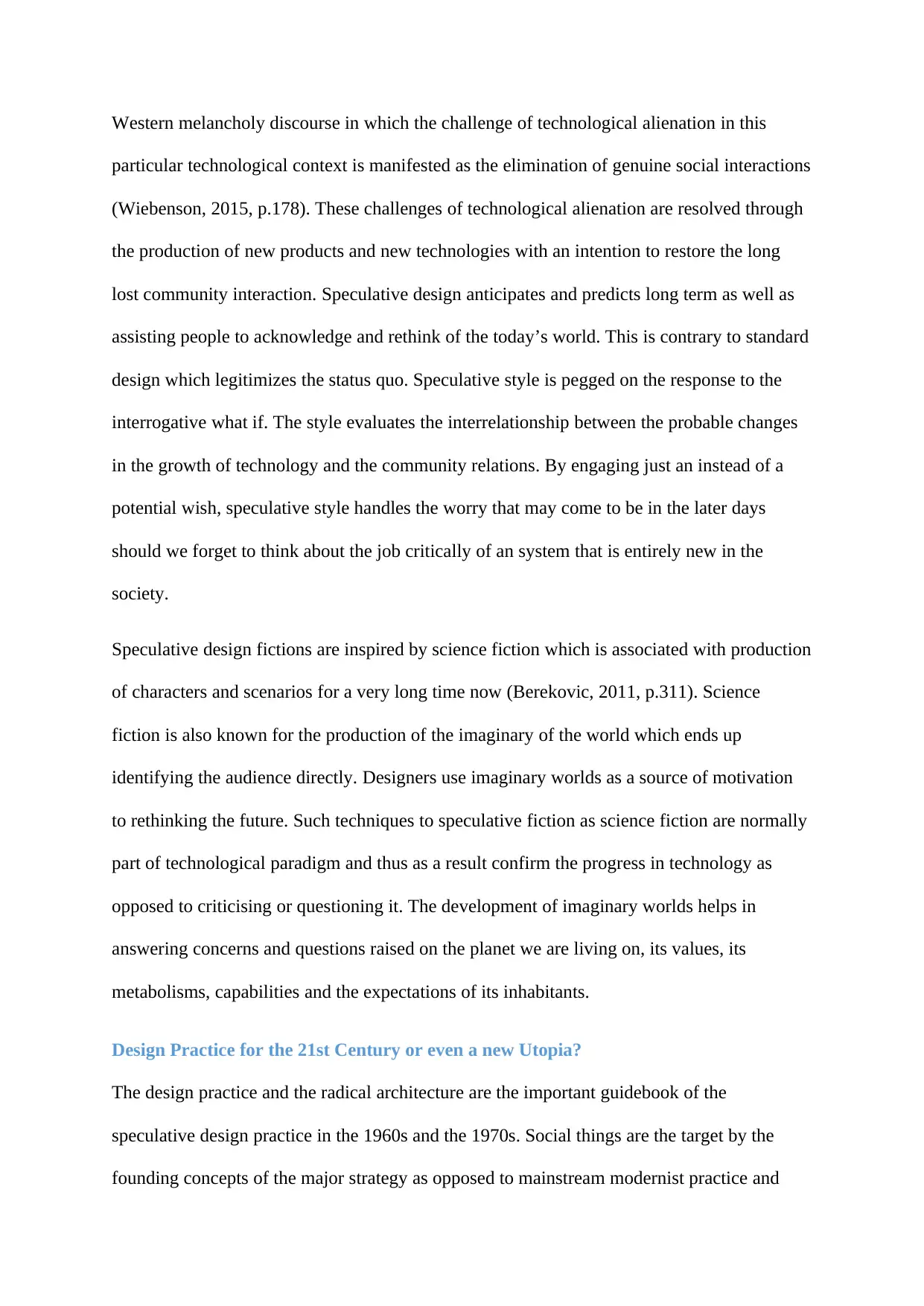
particular technological context is manifested as the elimination of genuine social interactions
(Wiebenson, 2015, p.178). These challenges of technological alienation are resolved through
the production of new products and new technologies with an intention to restore the long
lost community interaction. Speculative design anticipates and predicts long term as well as
assisting people to acknowledge and rethink of the today’s world. This is contrary to standard
design which legitimizes the status quo. Speculative style is pegged on the response to the
interrogative what if. The style evaluates the interrelationship between the probable changes
in the growth of technology and the community relations. By engaging just an instead of a
potential wish, speculative style handles the worry that may come to be in the later days
should we forget to think about the job critically of an system that is entirely new in the
society.
Speculative design fictions are inspired by science fiction which is associated with production
of characters and scenarios for a very long time now (Berekovic, 2011, p.311). Science
fiction is also known for the production of the imaginary of the world which ends up
identifying the audience directly. Designers use imaginary worlds as a source of motivation
to rethinking the future. Such techniques to speculative fiction as science fiction are normally
part of technological paradigm and thus as a result confirm the progress in technology as
opposed to criticising or questioning it. The development of imaginary worlds helps in
answering concerns and questions raised on the planet we are living on, its values, its
metabolisms, capabilities and the expectations of its inhabitants.
Design Practice for the 21st Century or even a new Utopia?
The design practice and the radical architecture are the important guidebook of the
speculative design practice in the 1960s and the 1970s. Social things are the target by the
founding concepts of the major strategy as opposed to mainstream modernist practice and
Paraphrase This Document
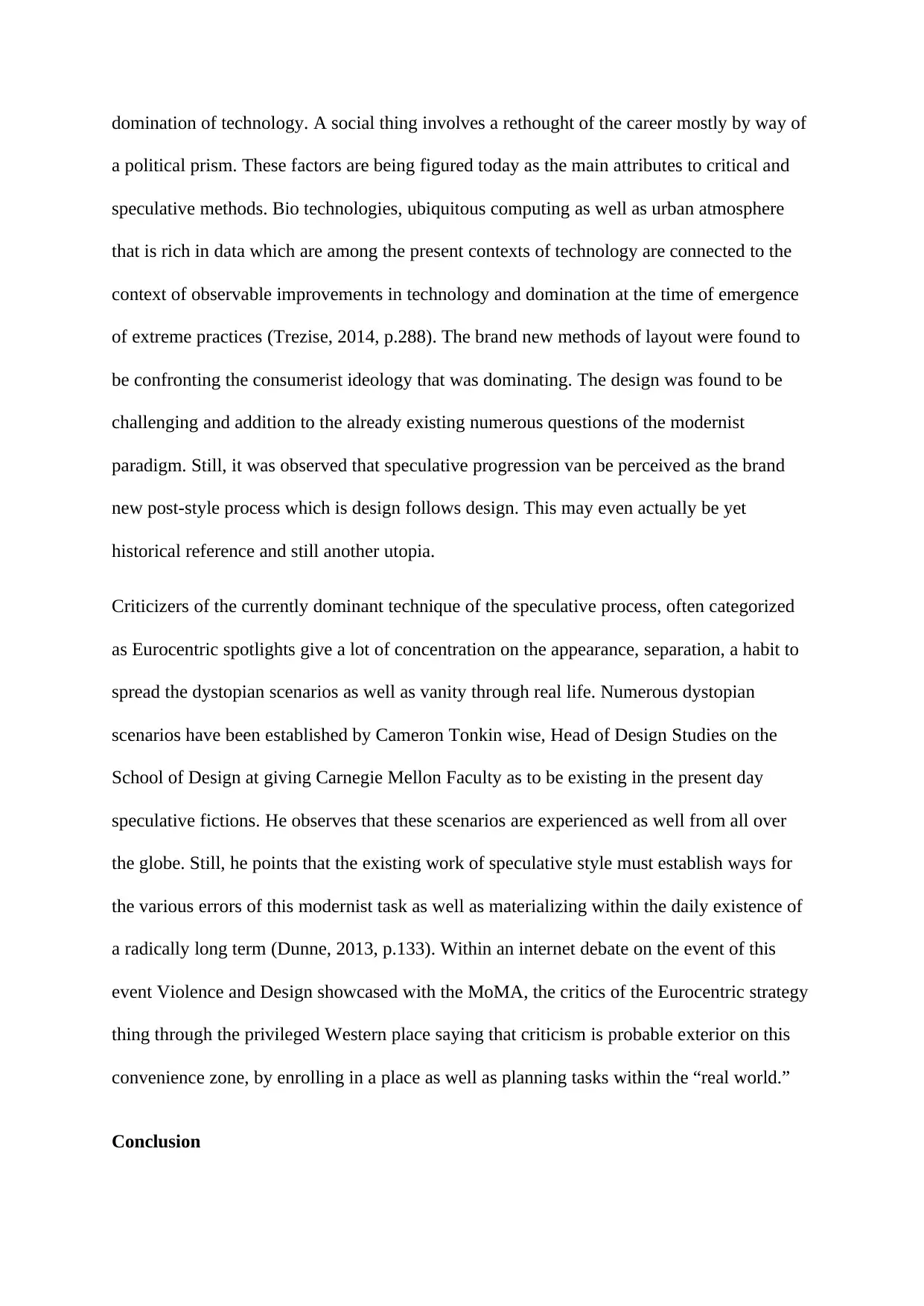
a political prism. These factors are being figured today as the main attributes to critical and
speculative methods. Bio technologies, ubiquitous computing as well as urban atmosphere
that is rich in data which are among the present contexts of technology are connected to the
context of observable improvements in technology and domination at the time of emergence
of extreme practices (Trezise, 2014, p.288). The brand new methods of layout were found to
be confronting the consumerist ideology that was dominating. The design was found to be
challenging and addition to the already existing numerous questions of the modernist
paradigm. Still, it was observed that speculative progression van be perceived as the brand
new post-style process which is design follows design. This may even actually be yet
historical reference and still another utopia.
Criticizers of the currently dominant technique of the speculative process, often categorized
as Eurocentric spotlights give a lot of concentration on the appearance, separation, a habit to
spread the dystopian scenarios as well as vanity through real life. Numerous dystopian
scenarios have been established by Cameron Tonkin wise, Head of Design Studies on the
School of Design at giving Carnegie Mellon Faculty as to be existing in the present day
speculative fictions. He observes that these scenarios are experienced as well from all over
the globe. Still, he points that the existing work of speculative style must establish ways for
the various errors of this modernist task as well as materializing within the daily existence of
a radically long term (Dunne, 2013, p.133). Within an internet debate on the event of this
event Violence and Design showcased with the MoMA, the critics of the Eurocentric strategy
thing through the privileged Western place saying that criticism is probable exterior on this
convenience zone, by enrolling in a place as well as planning tasks within the “real world.”
Conclusion
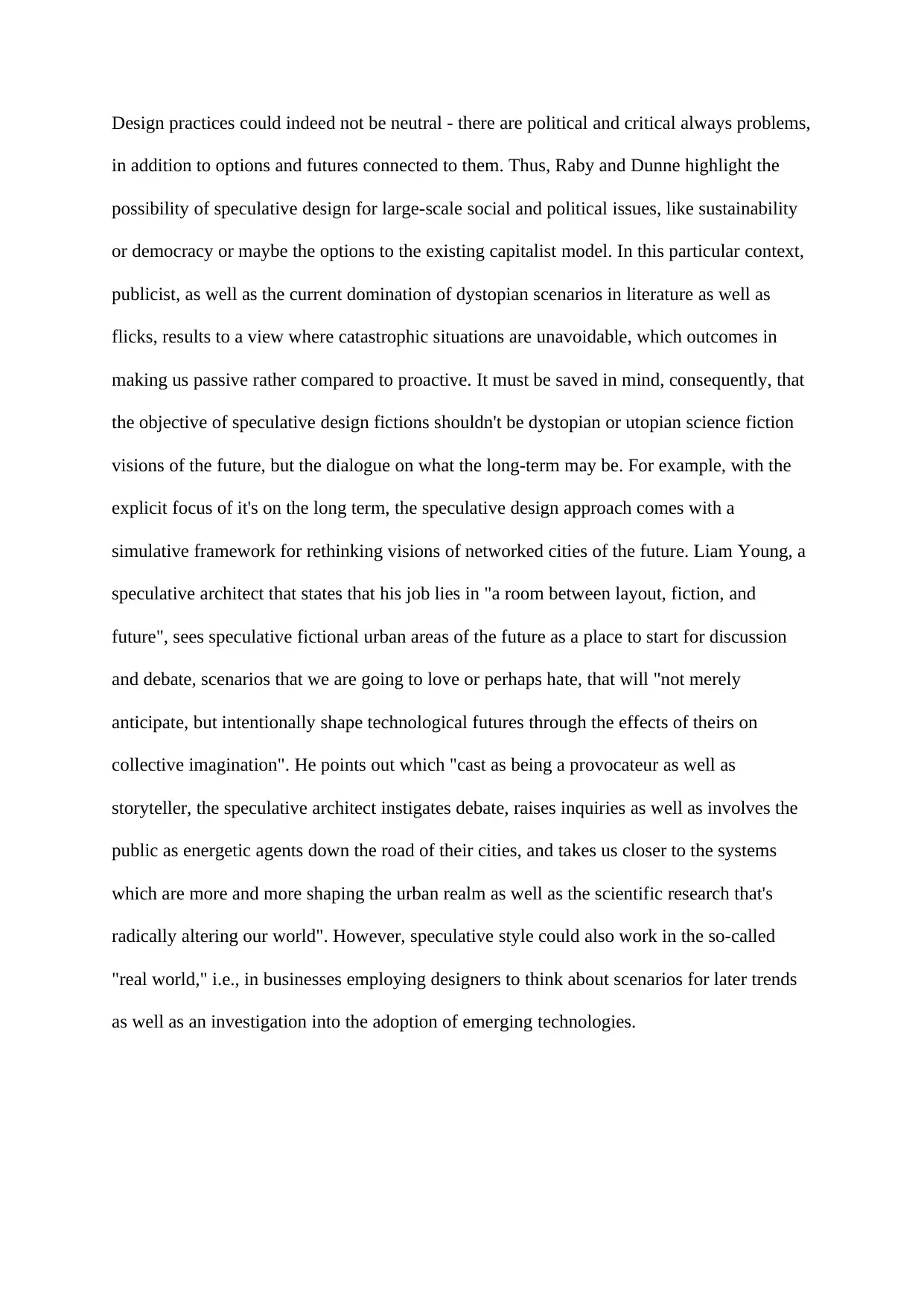
in addition to options and futures connected to them. Thus, Raby and Dunne highlight the
possibility of speculative design for large-scale social and political issues, like sustainability
or democracy or maybe the options to the existing capitalist model. In this particular context,
publicist, as well as the current domination of dystopian scenarios in literature as well as
flicks, results to a view where catastrophic situations are unavoidable, which outcomes in
making us passive rather compared to proactive. It must be saved in mind, consequently, that
the objective of speculative design fictions shouldn't be dystopian or utopian science fiction
visions of the future, but the dialogue on what the long-term may be. For example, with the
explicit focus of it's on the long term, the speculative design approach comes with a
simulative framework for rethinking visions of networked cities of the future. Liam Young, a
speculative architect that states that his job lies in "a room between layout, fiction, and
future", sees speculative fictional urban areas of the future as a place to start for discussion
and debate, scenarios that we are going to love or perhaps hate, that will "not merely
anticipate, but intentionally shape technological futures through the effects of theirs on
collective imagination". He points out which "cast as being a provocateur as well as
storyteller, the speculative architect instigates debate, raises inquiries as well as involves the
public as energetic agents down the road of their cities, and takes us closer to the systems
which are more and more shaping the urban realm as well as the scientific research that's
radically altering our world". However, speculative style could also work in the so-called
"real world," i.e., in businesses employing designers to think about scenarios for later trends
as well as an investigation into the adoption of emerging technologies.
⊘ This is a preview!⊘
Do you want full access?
Subscribe today to unlock all pages.

Trusted by 1+ million students worldwide

Laboratory).All merchandise has to be contained in the center to become practical on the
common store. Speculative services and products (including worlds and systems) could be
fictionalized as current in the middle.
References
Berekovic, M., 2011. Architecture of Computing Systems - ARCS 2011: 24th International
Conference, Lake Como, Italy, February 24-25, 2011. Proceedings. 5th ed. London:
Springer.
Dunne, A., 2013. Speculative Everything: Design, Fiction, and Social Dreaming. 5th ed.
London: MIT Press.
Johnson, J.S., 2016. Digital Design Exercises for Architecture Students. 4th ed. New York:
Routledge.
Latham, R., 2014. The Oxford Handbook of Science Fiction. 4th ed. Oxford: Oxford
University Press.
Lilja, D.J., 2012. The Interaction of Compilation Technology and Computer Architecture. 4th
ed. New York: Springer Science & Business Media.
Paraphrase This Document
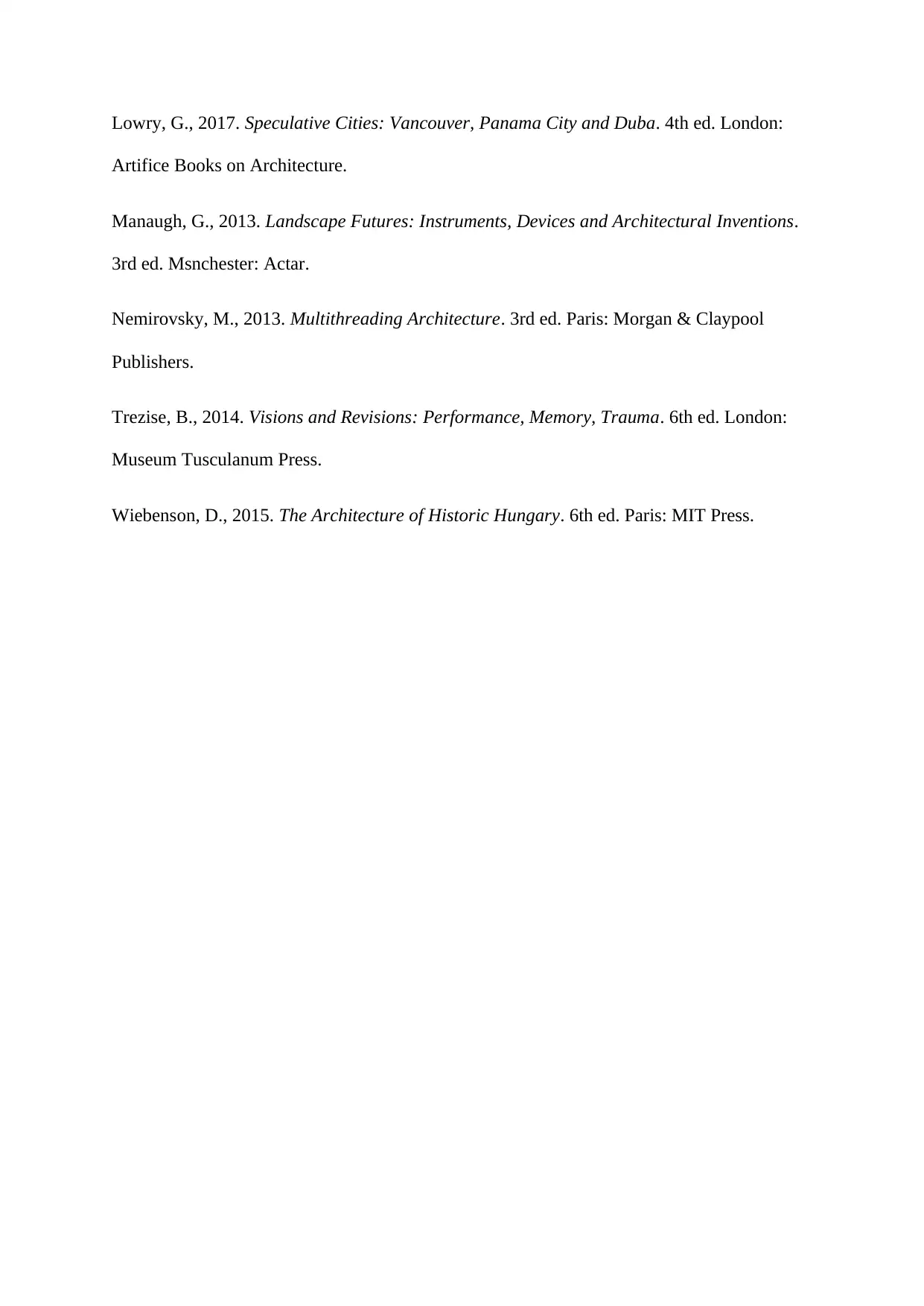
Artifice Books on Architecture.
Manaugh, G., 2013. Landscape Futures: Instruments, Devices and Architectural Inventions.
3rd ed. Msnchester: Actar.
Nemirovsky, M., 2013. Multithreading Architecture. 3rd ed. Paris: Morgan & Claypool
Publishers.
Trezise, B., 2014. Visions and Revisions: Performance, Memory, Trauma. 6th ed. London:
Museum Tusculanum Press.
Wiebenson, D., 2015. The Architecture of Historic Hungary. 6th ed. Paris: MIT Press.
Your All-in-One AI-Powered Toolkit for Academic Success.
+13062052269
info@desklib.com
Available 24*7 on WhatsApp / Email
![[object Object]](/_next/static/media/star-bottom.7253800d.svg)
© 2024 | Zucol Services PVT LTD | All rights reserved.

